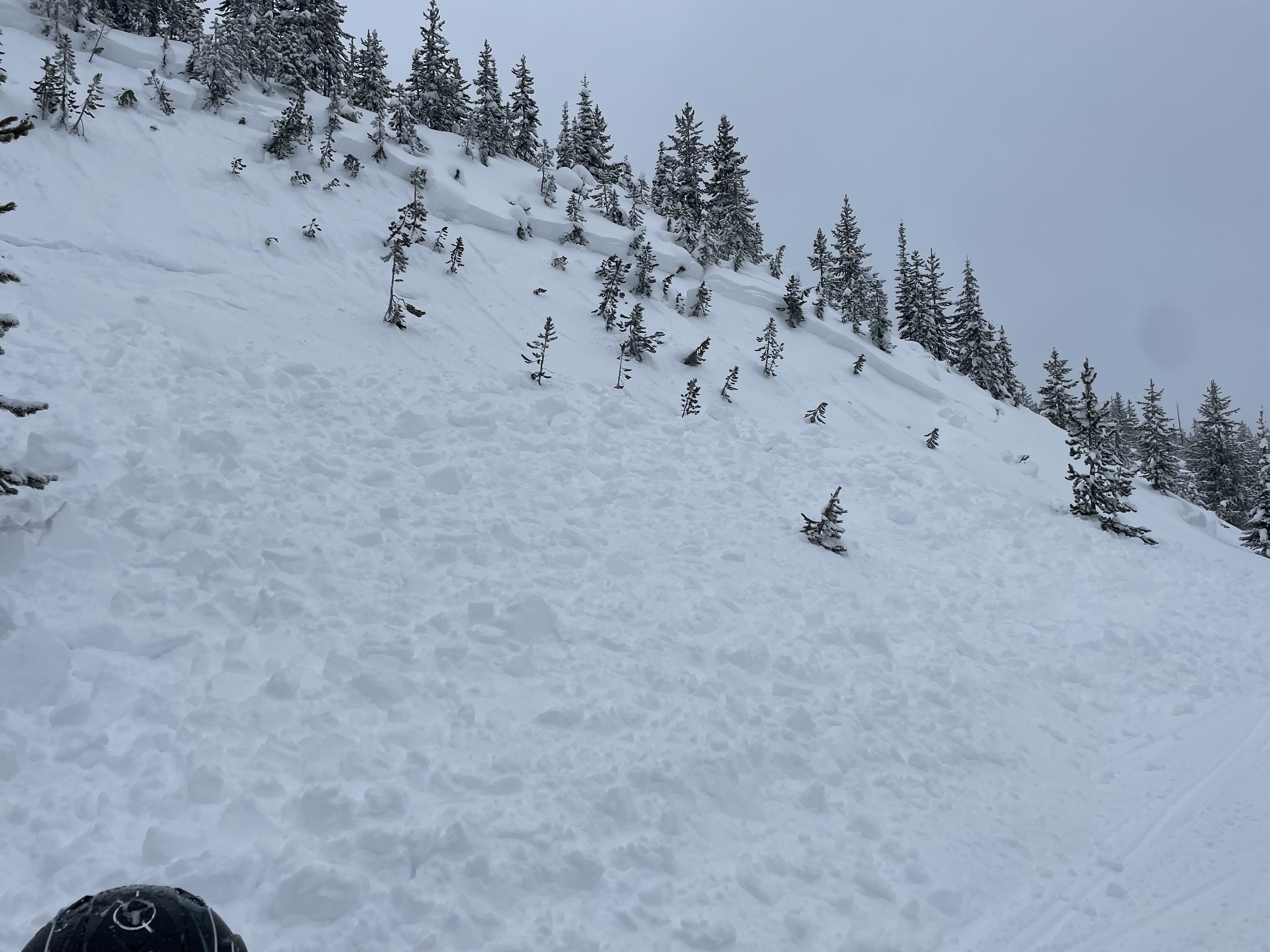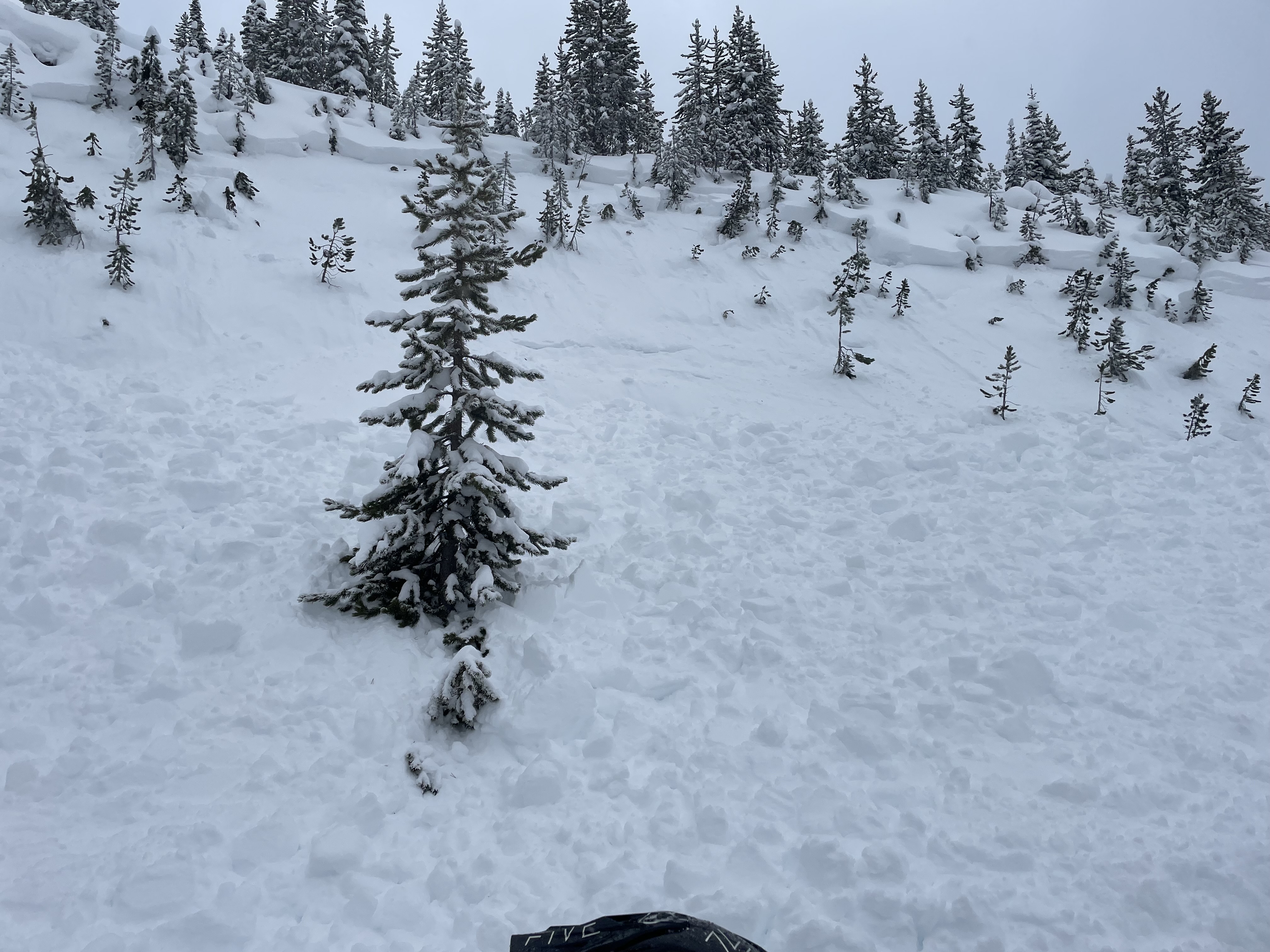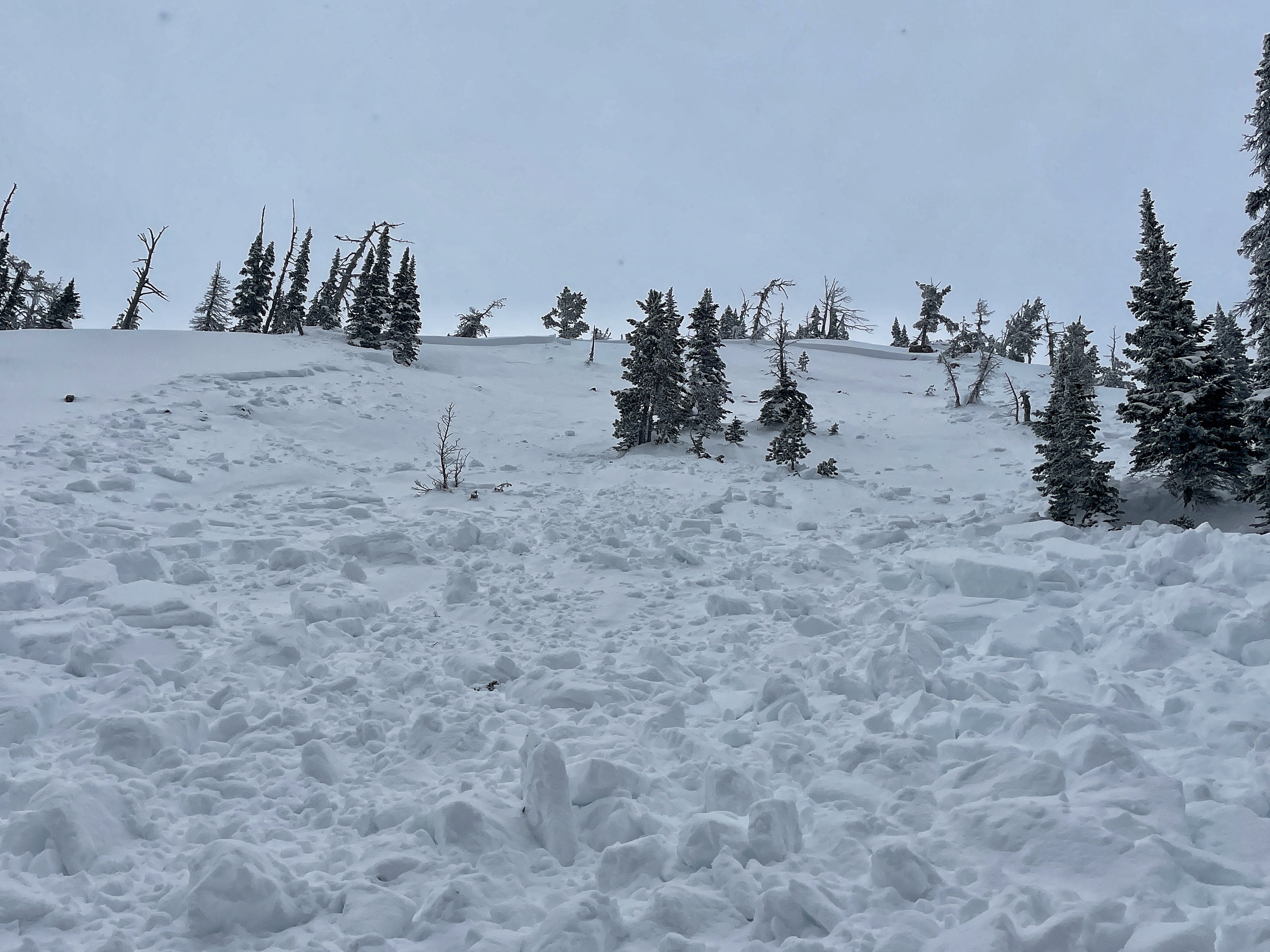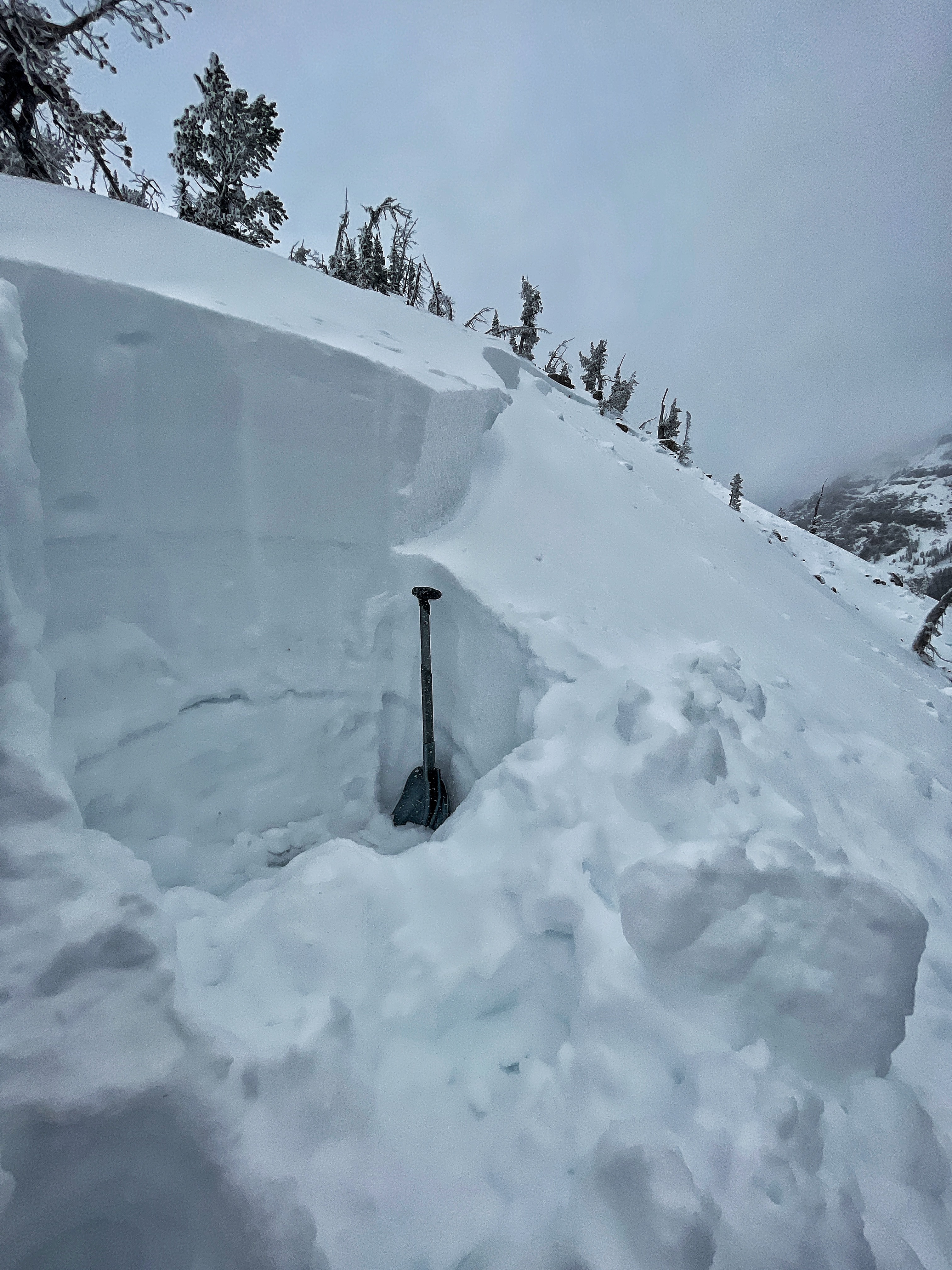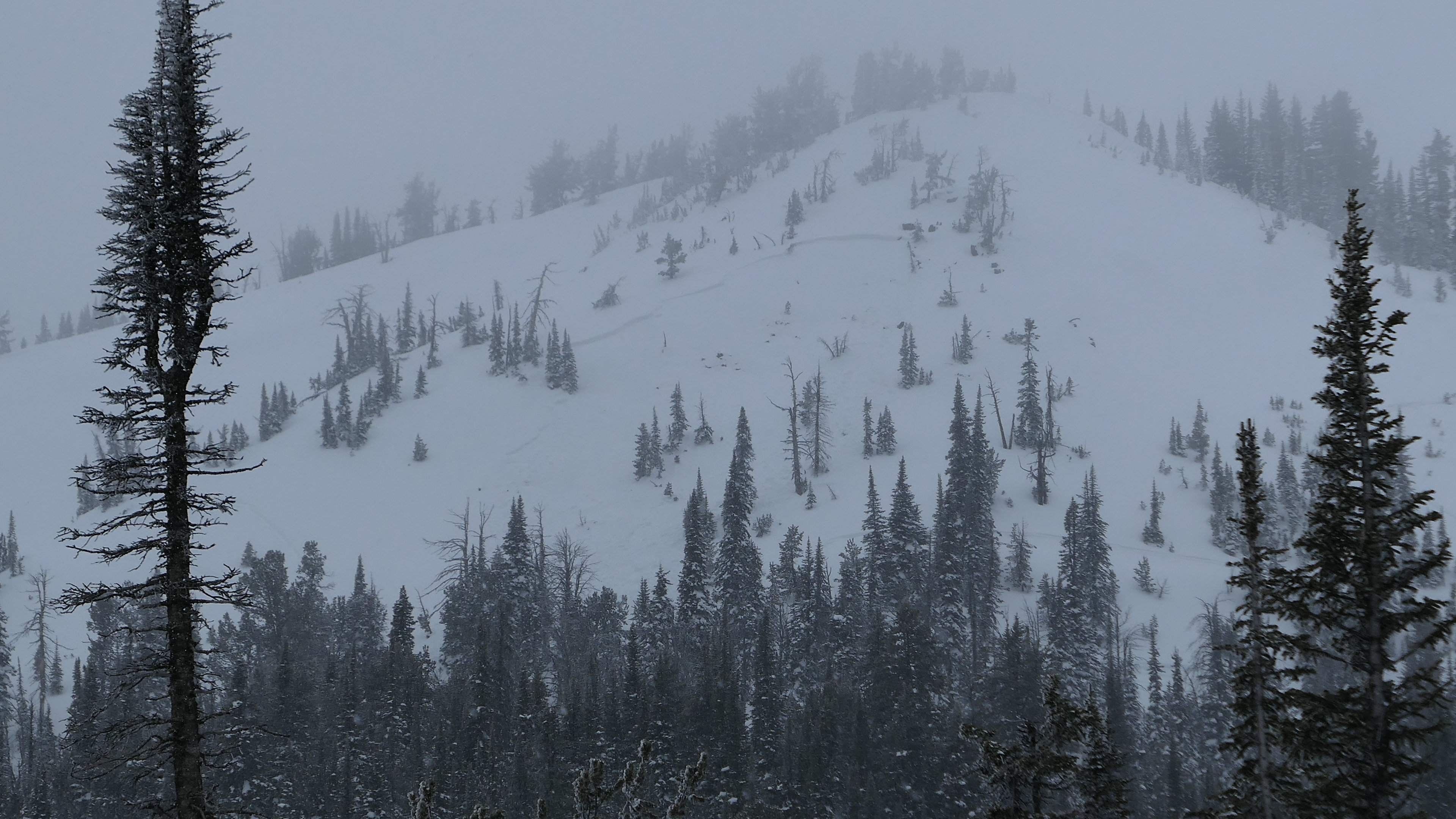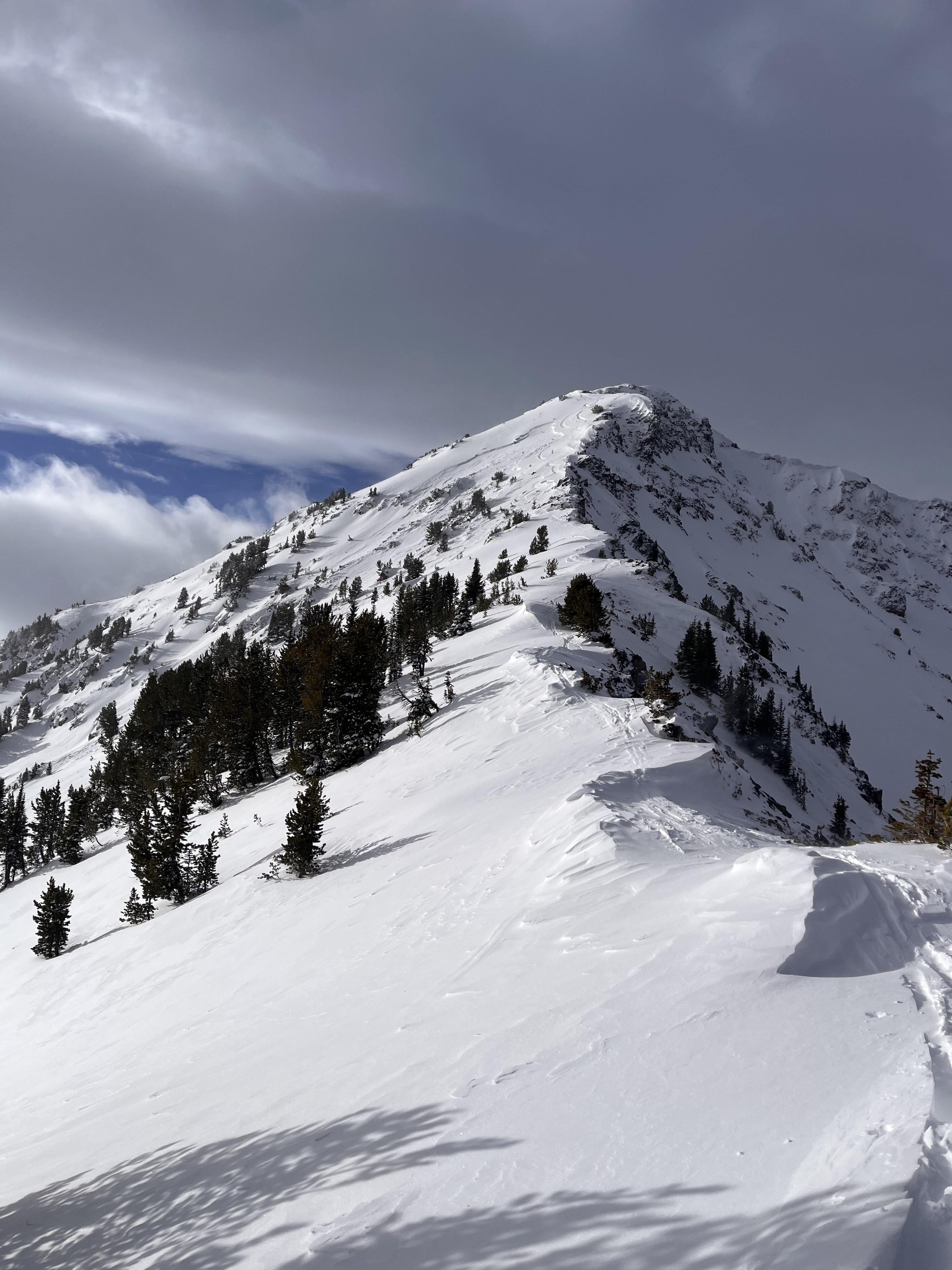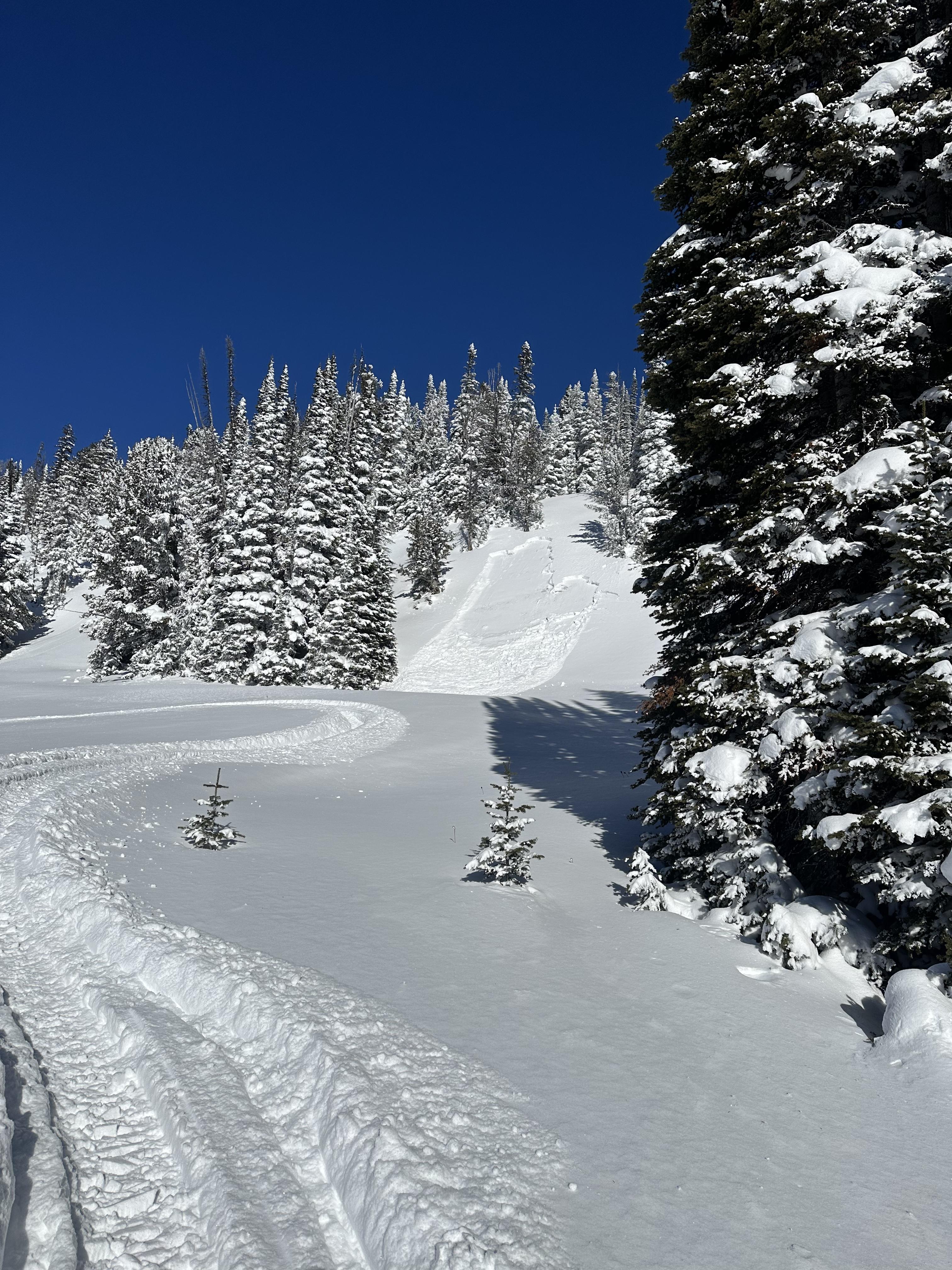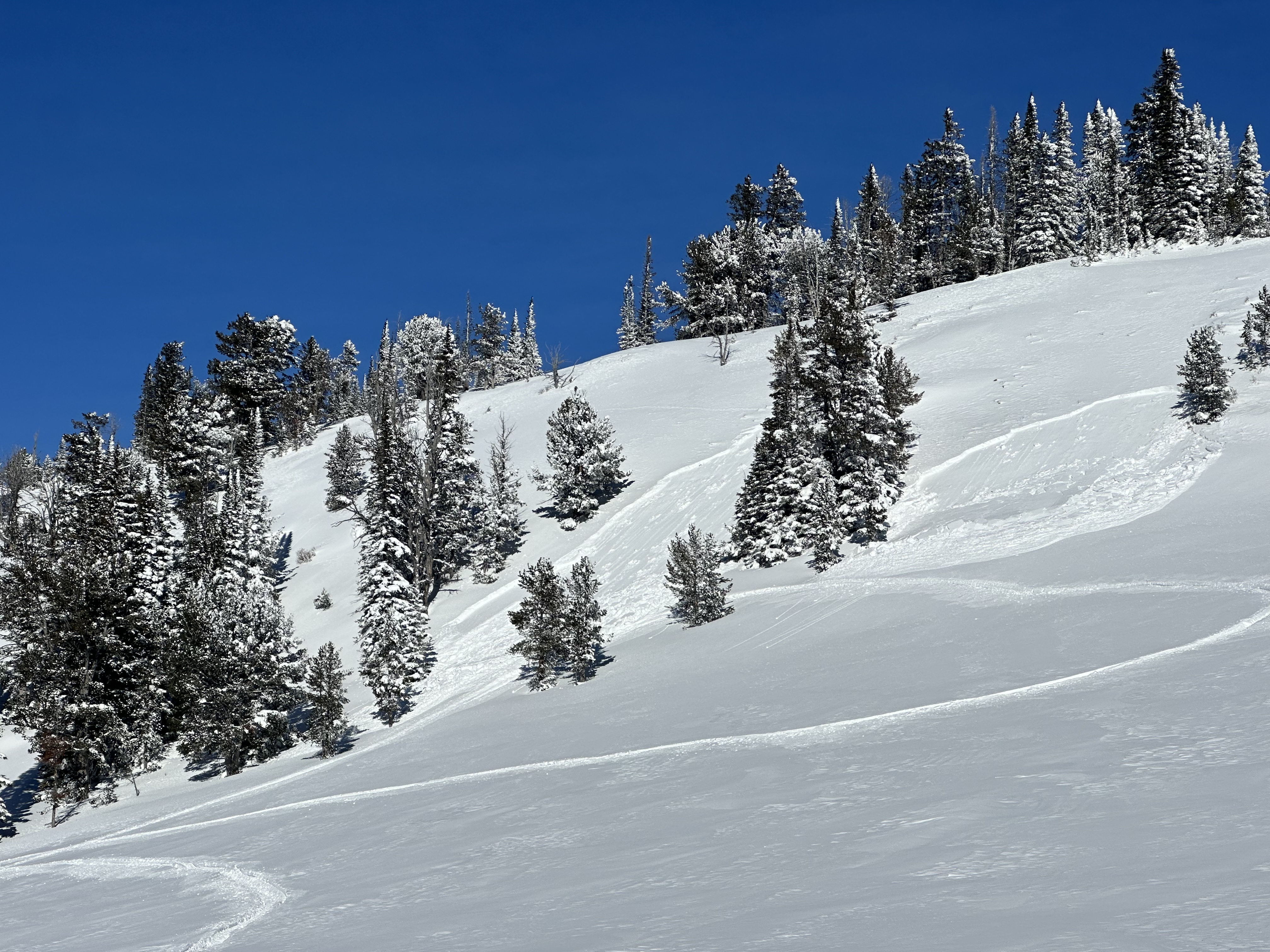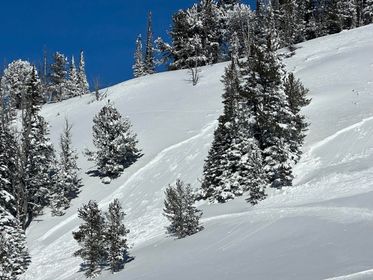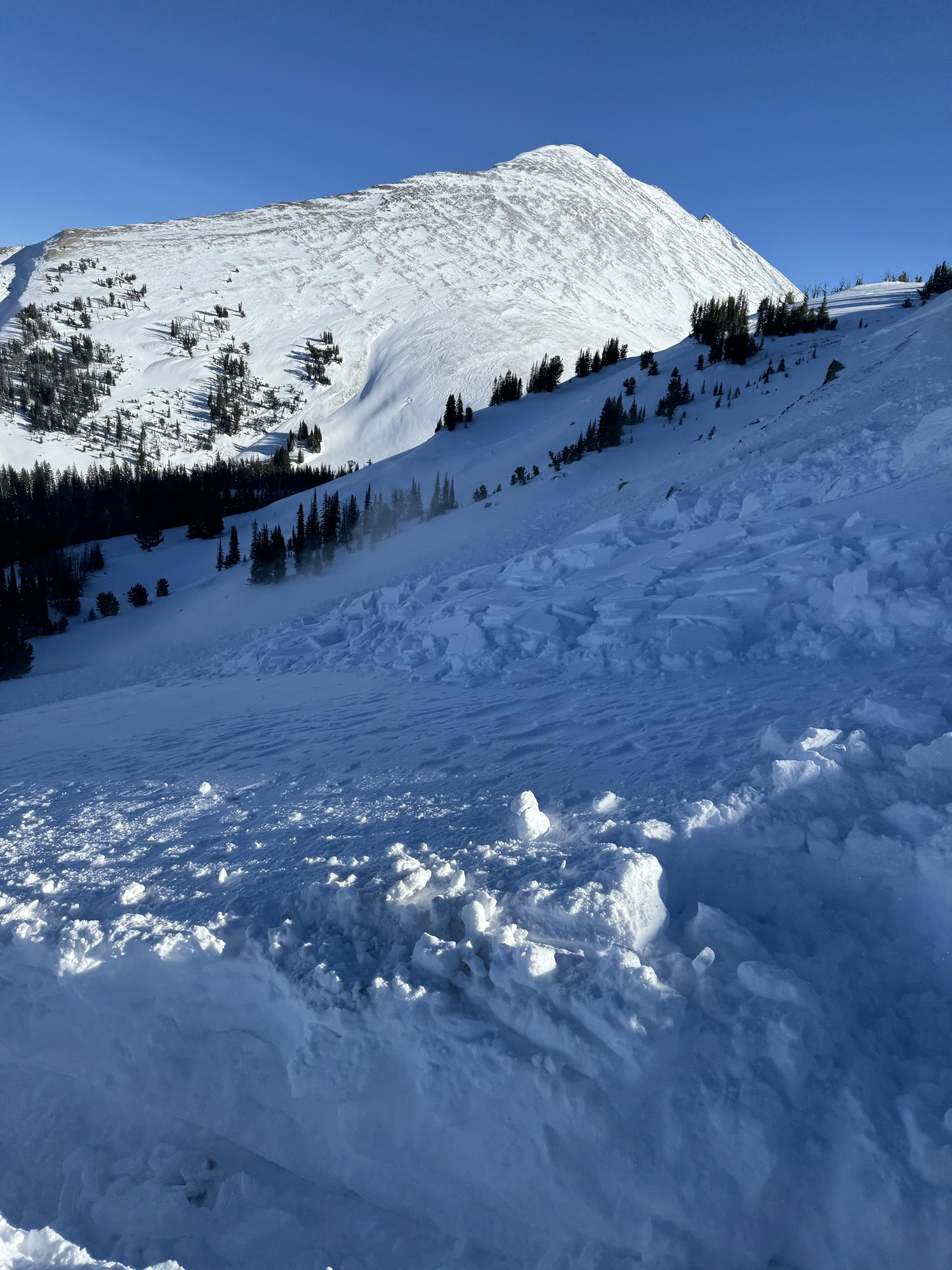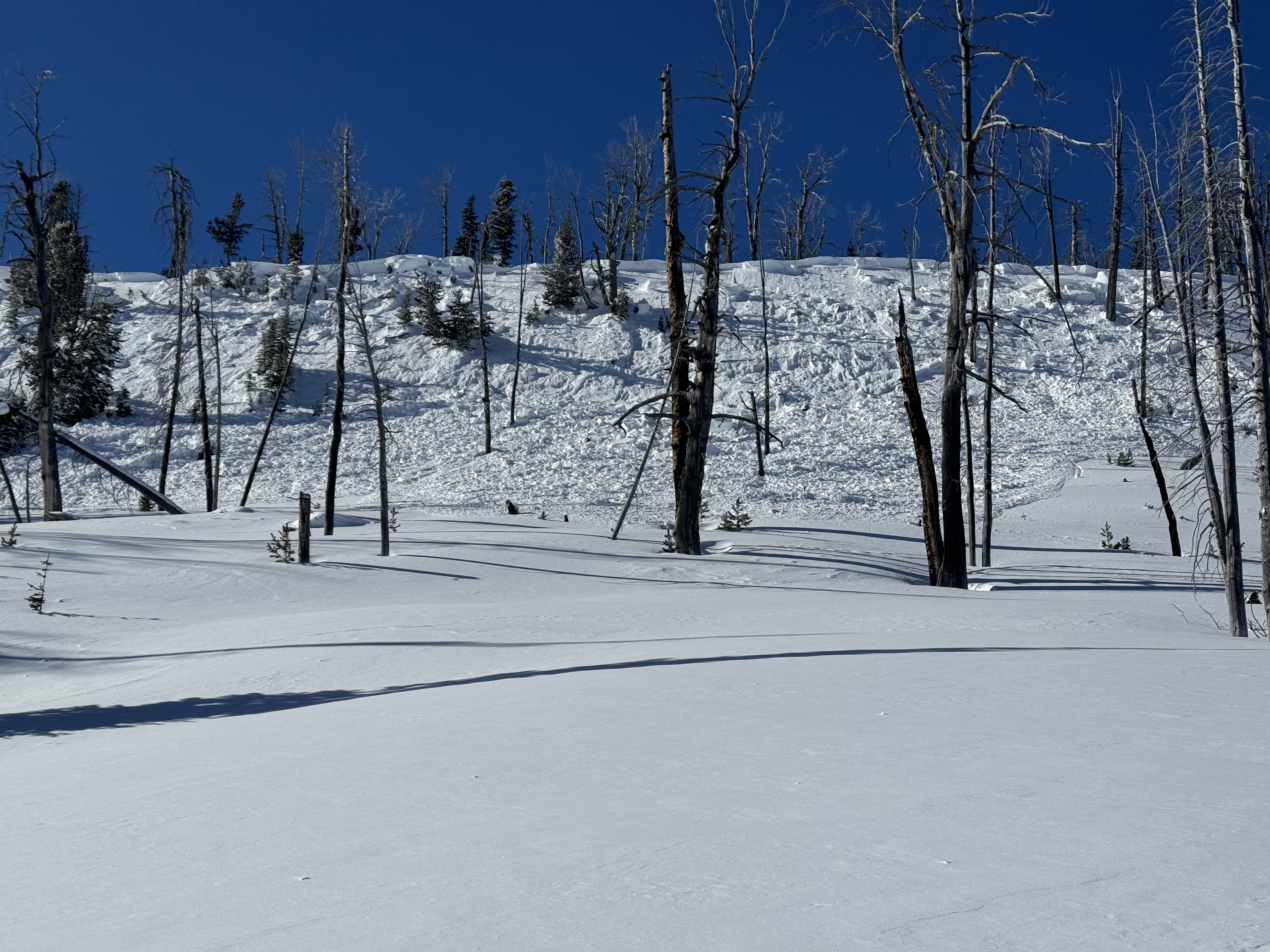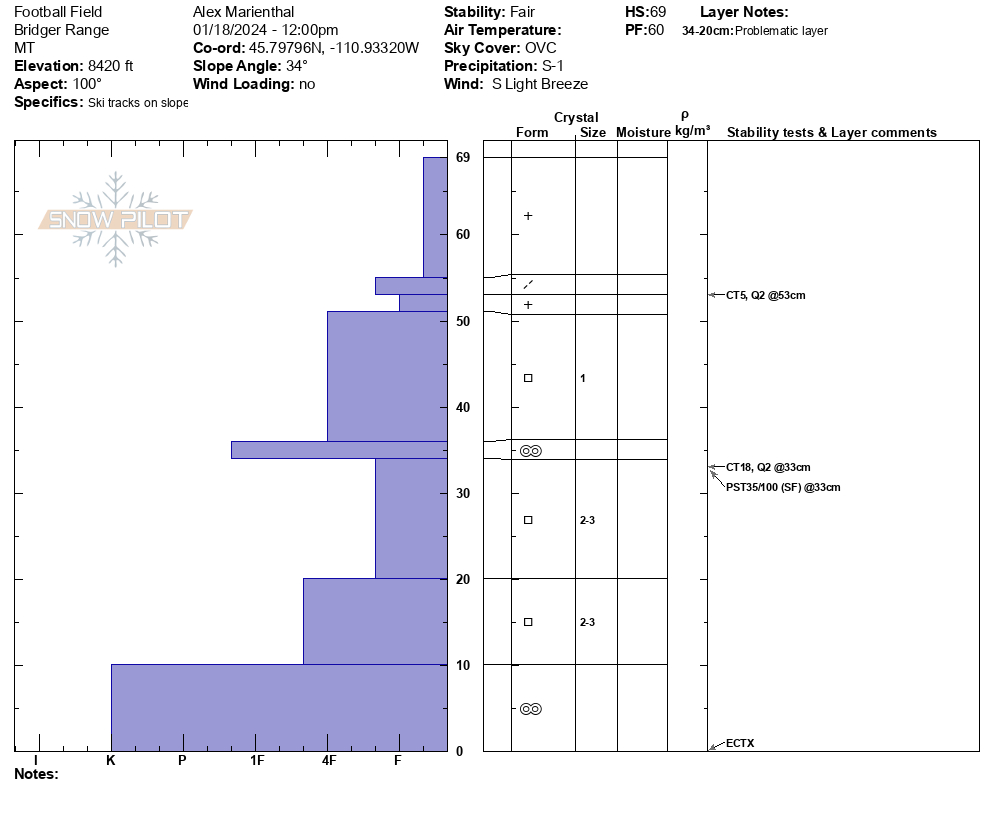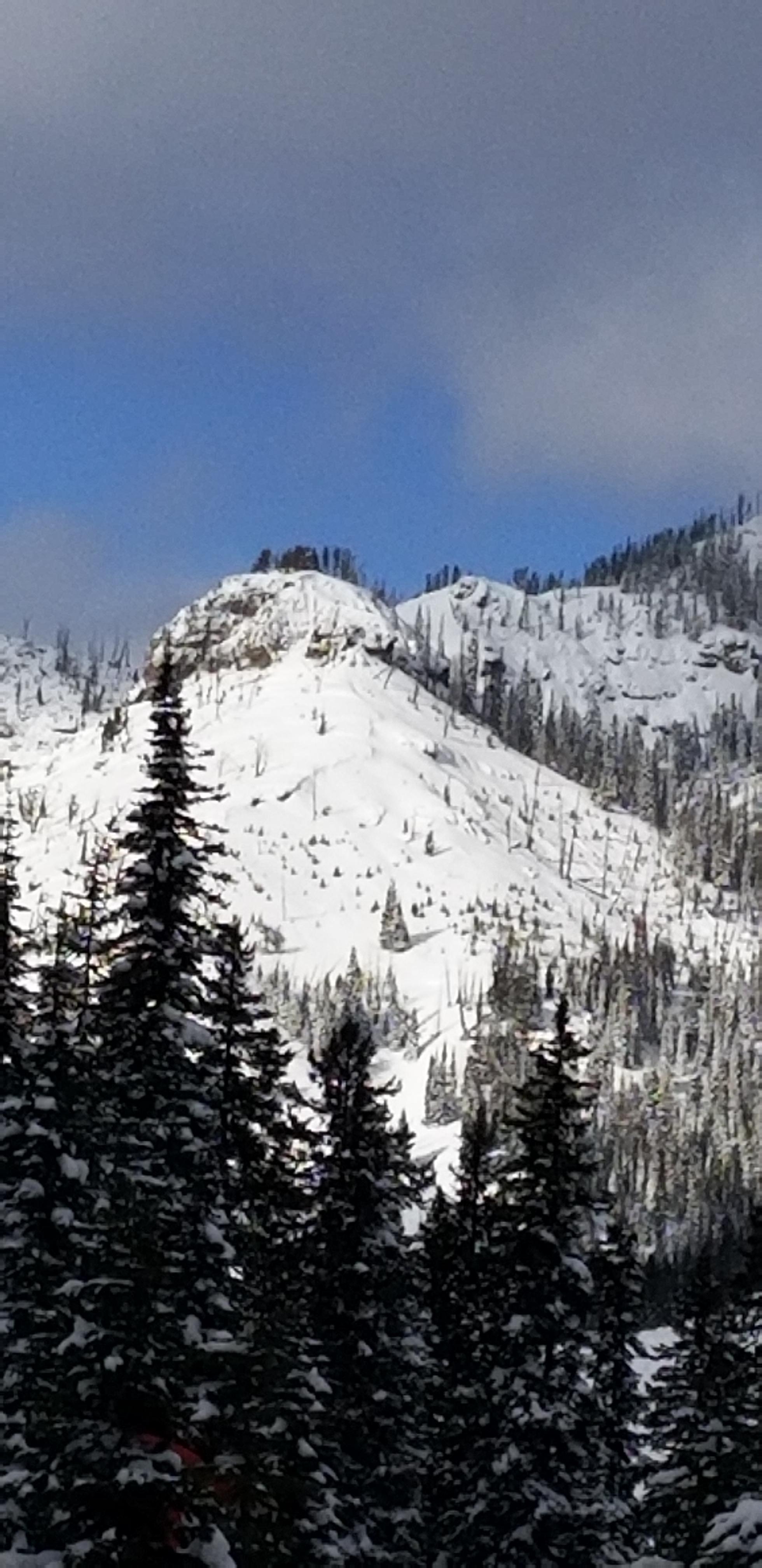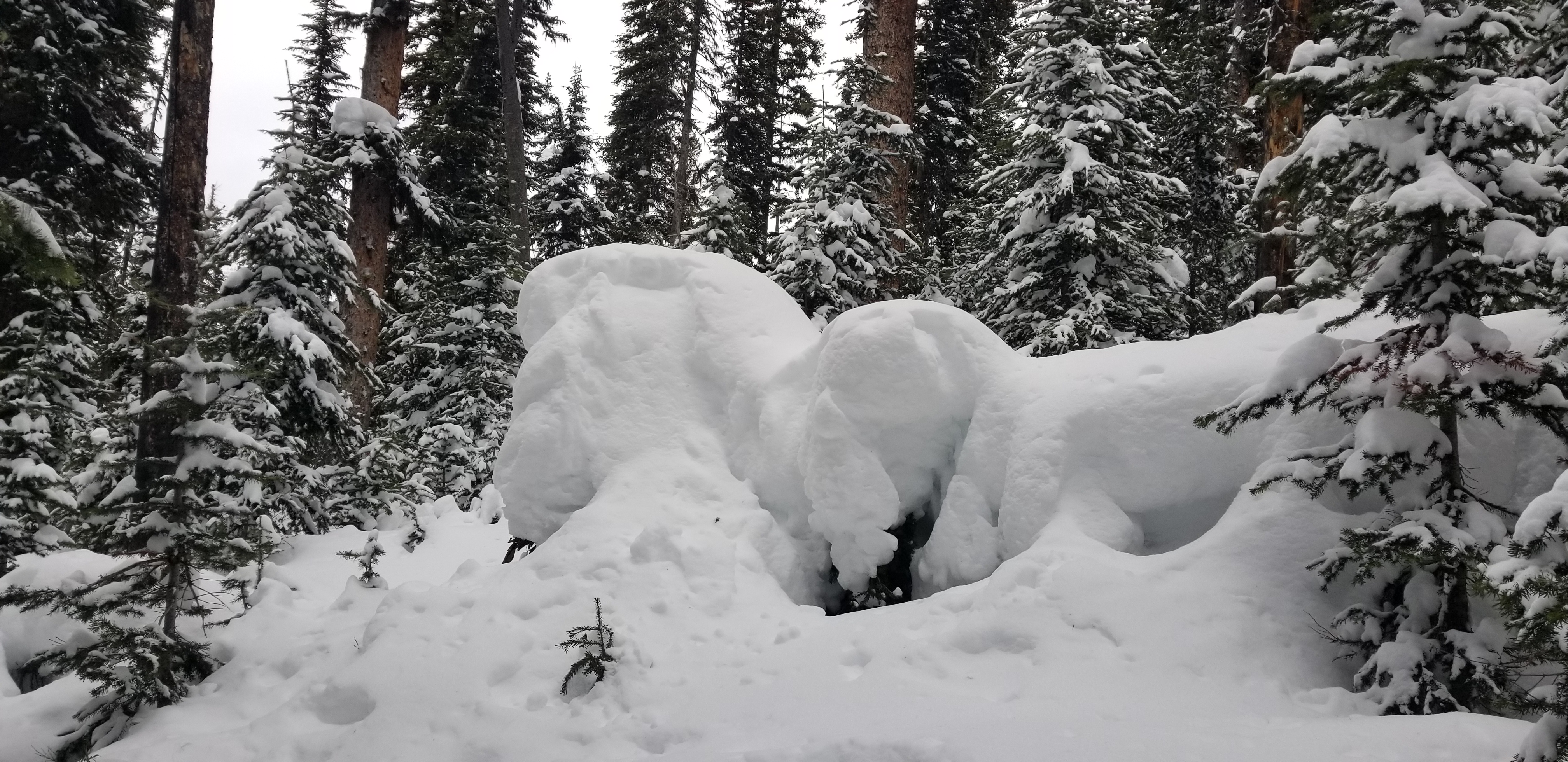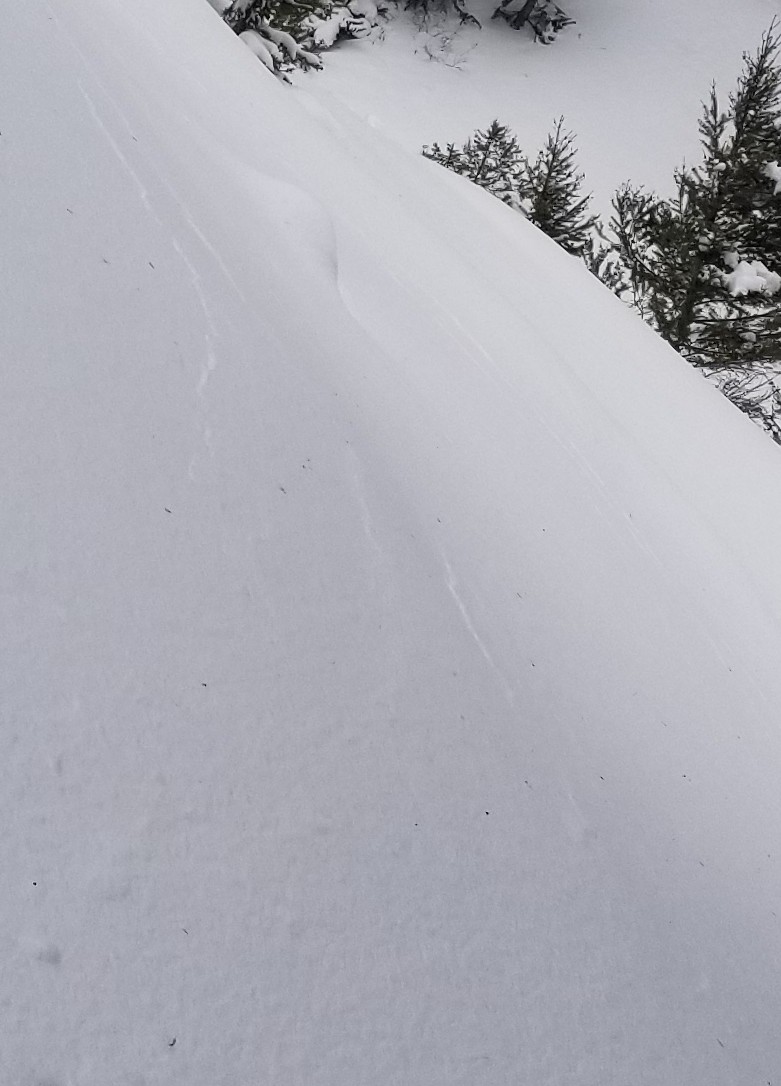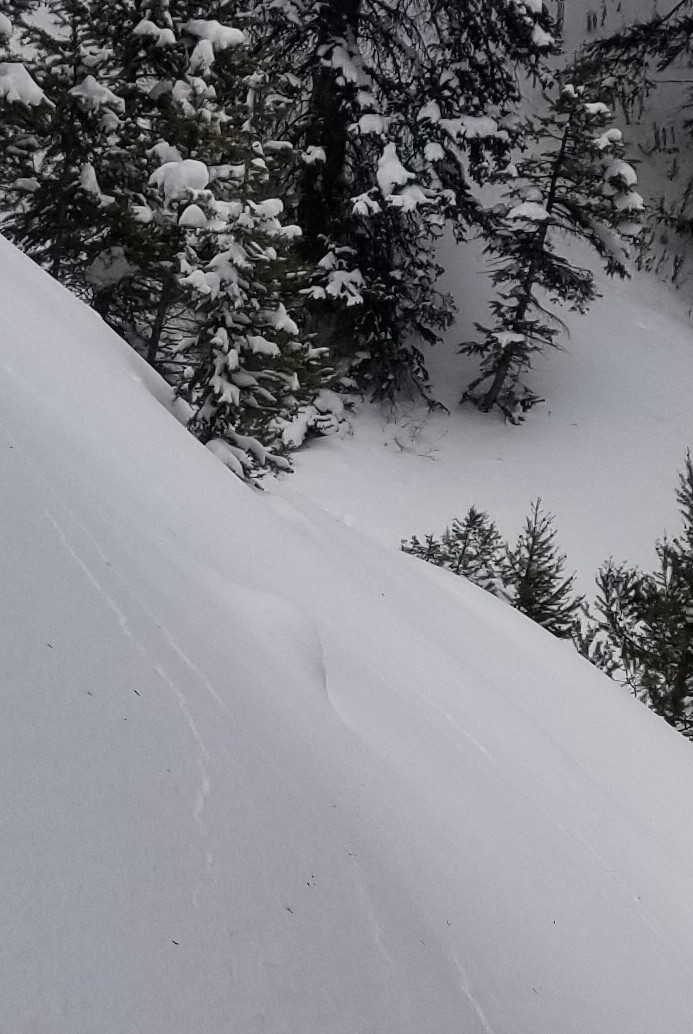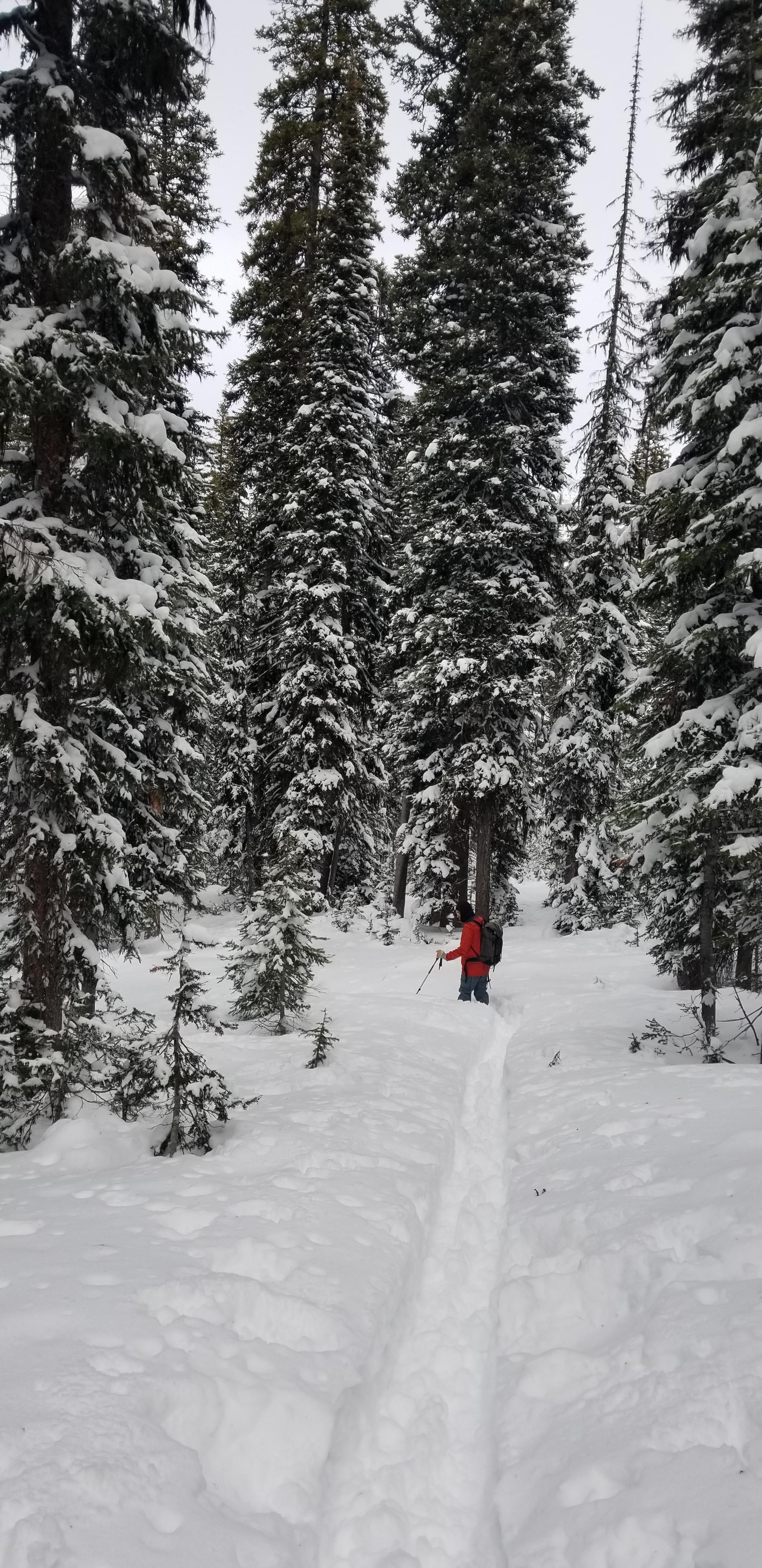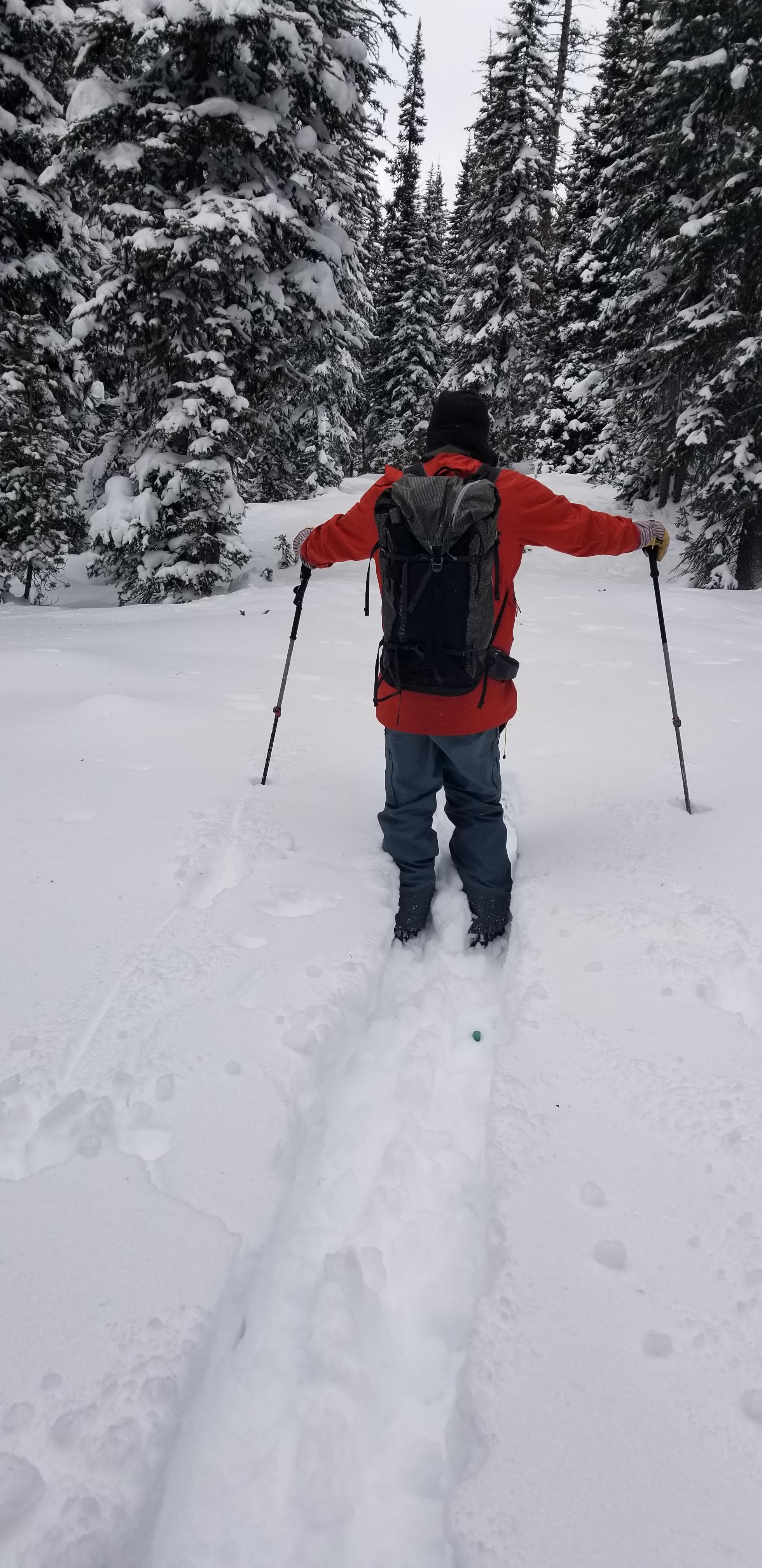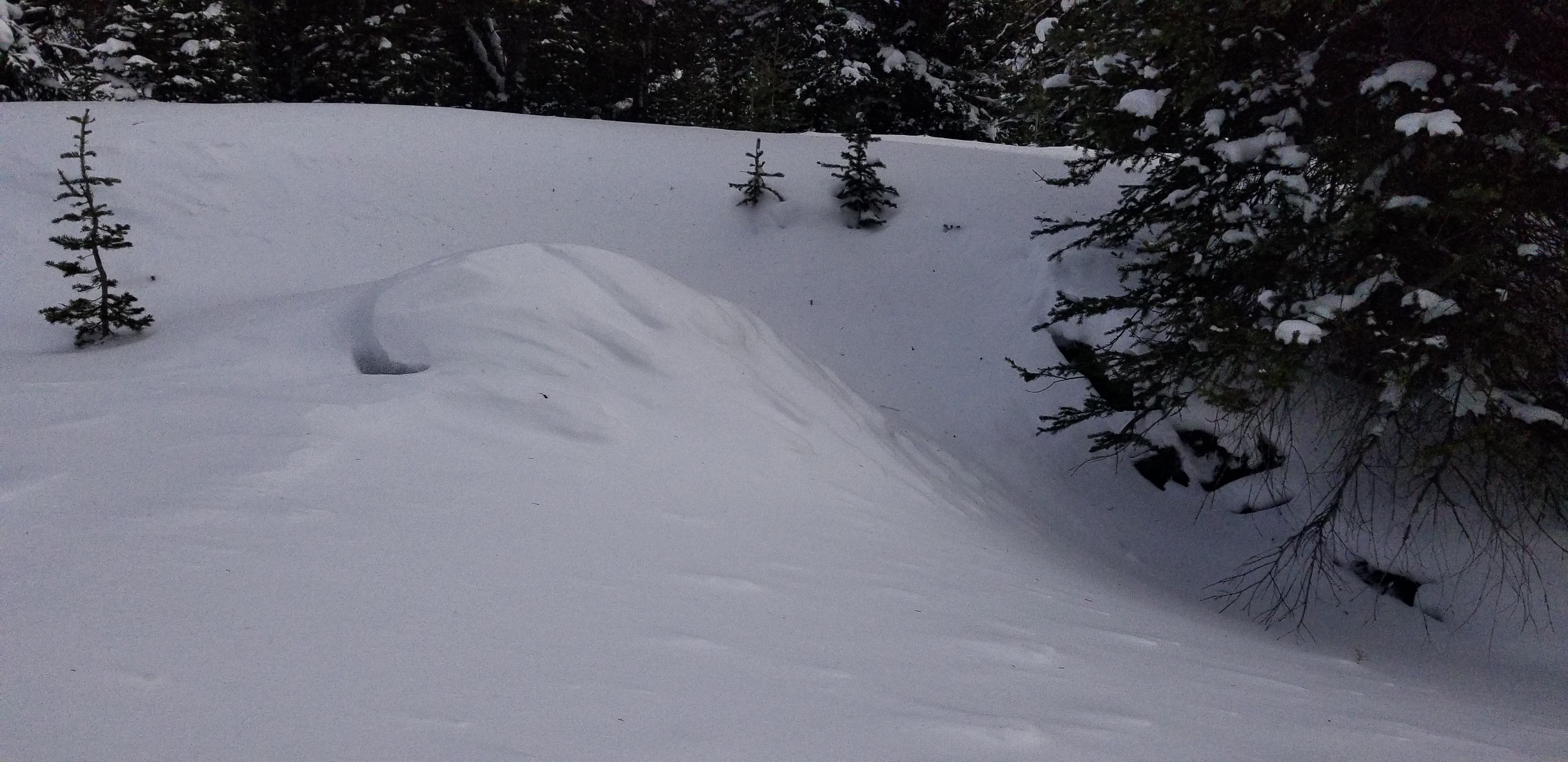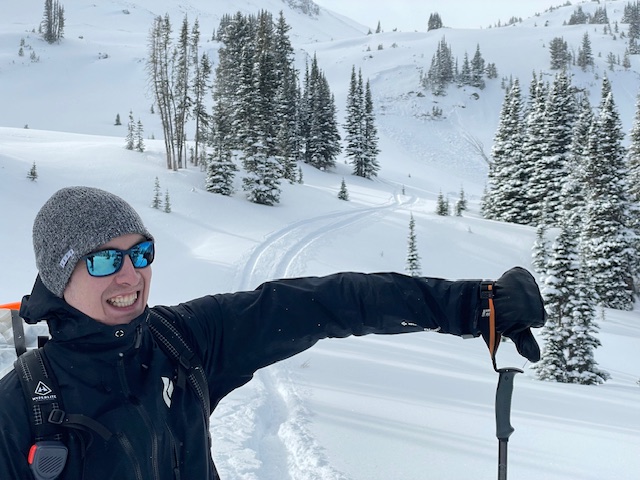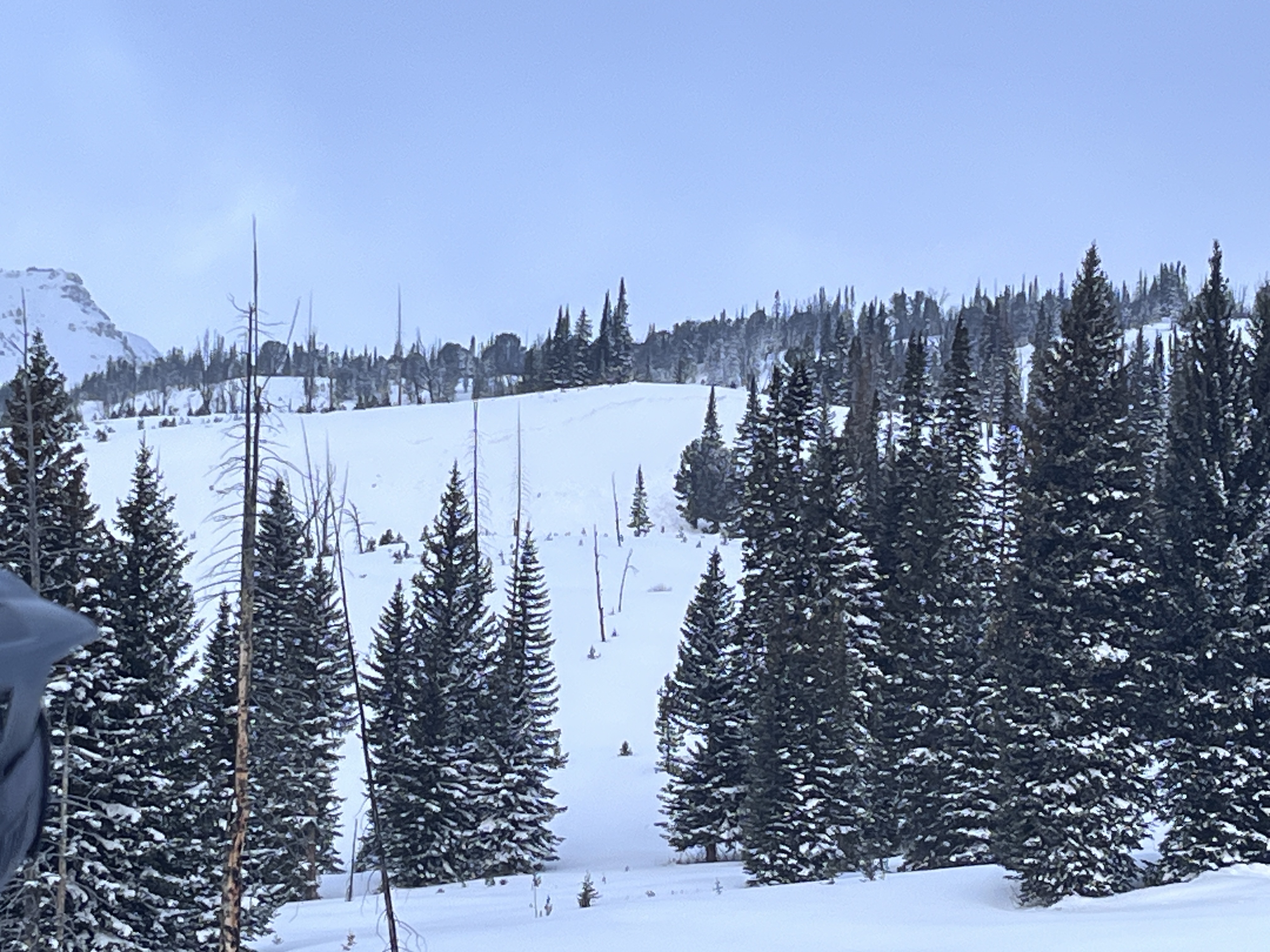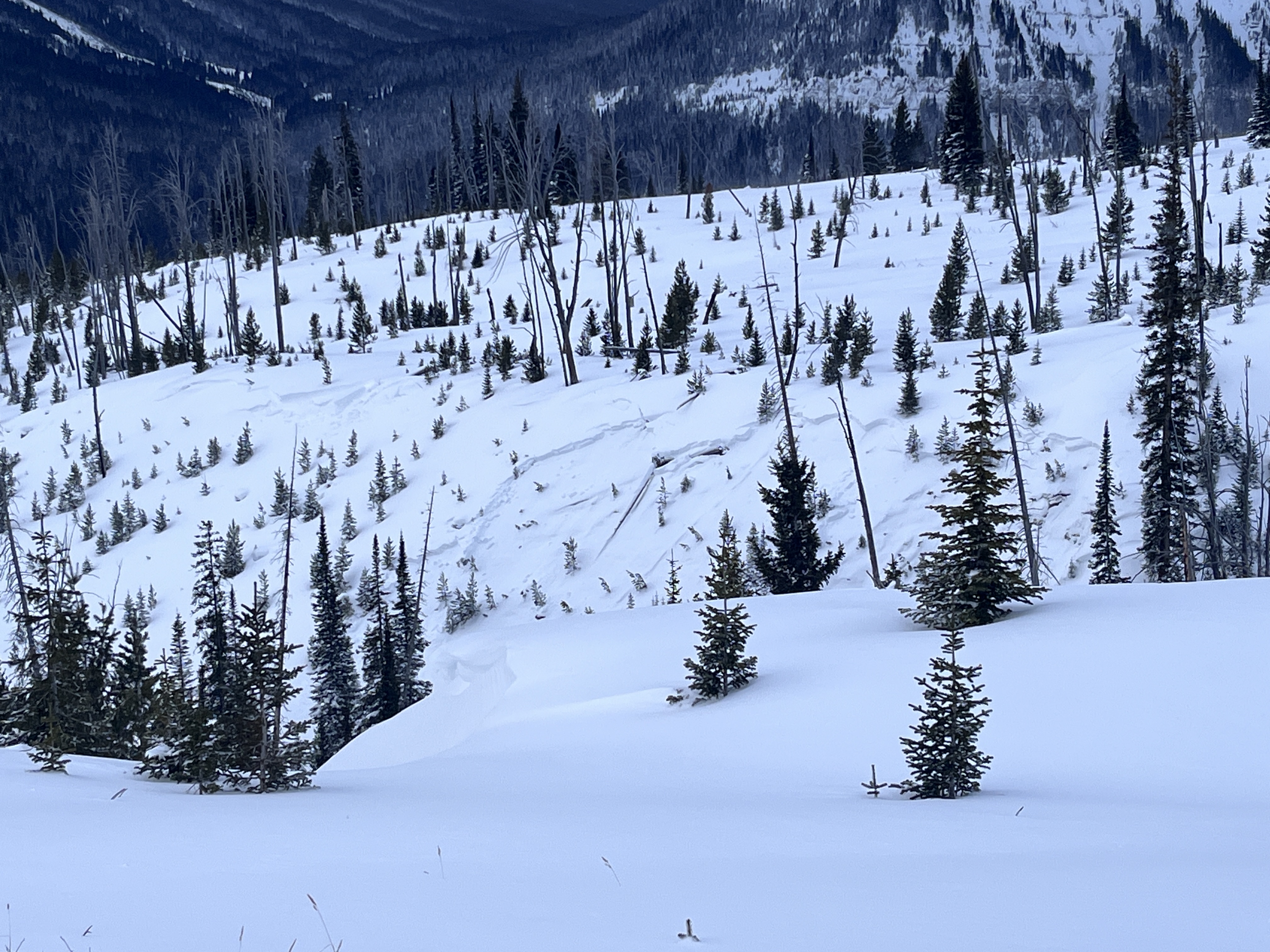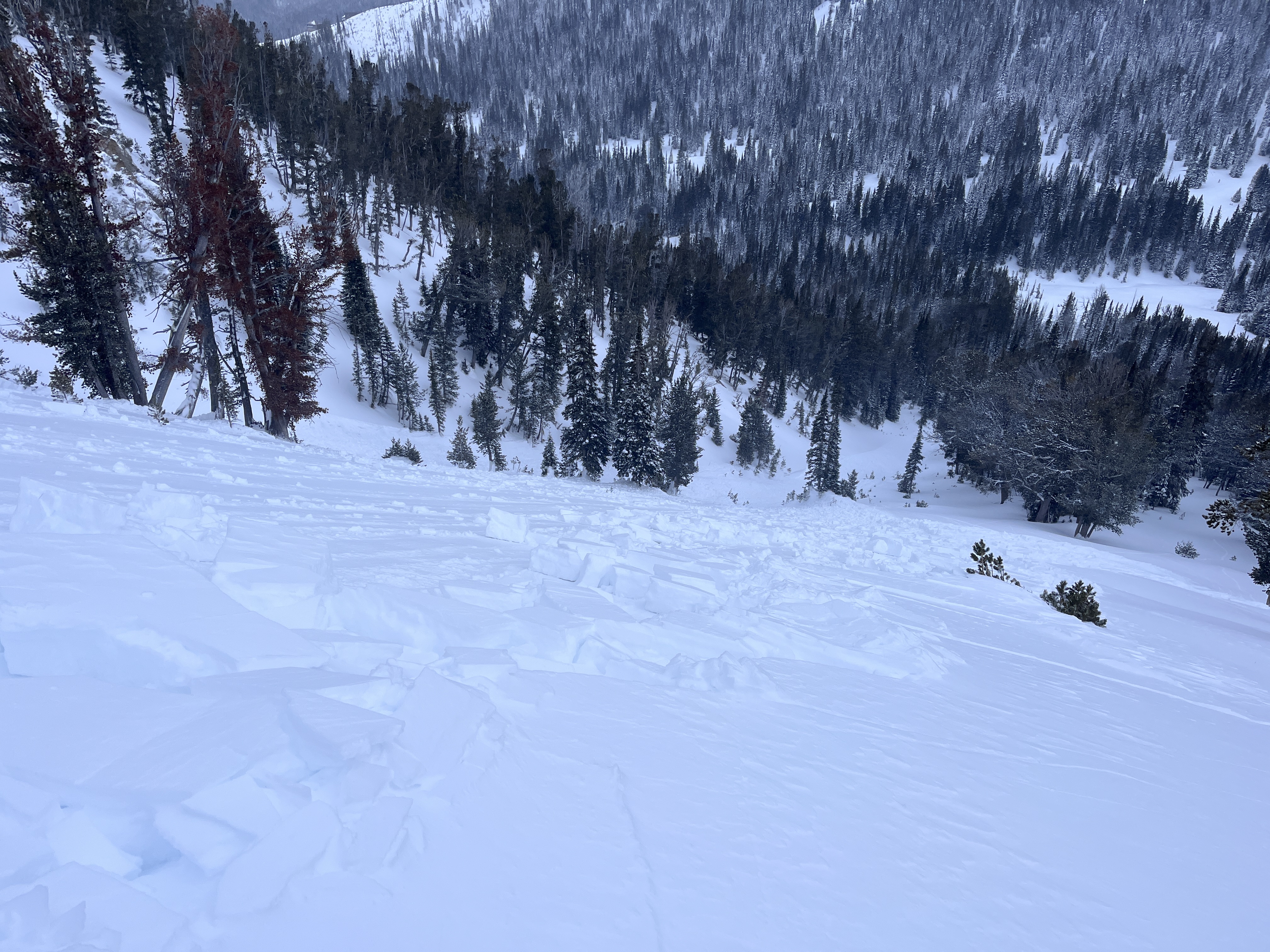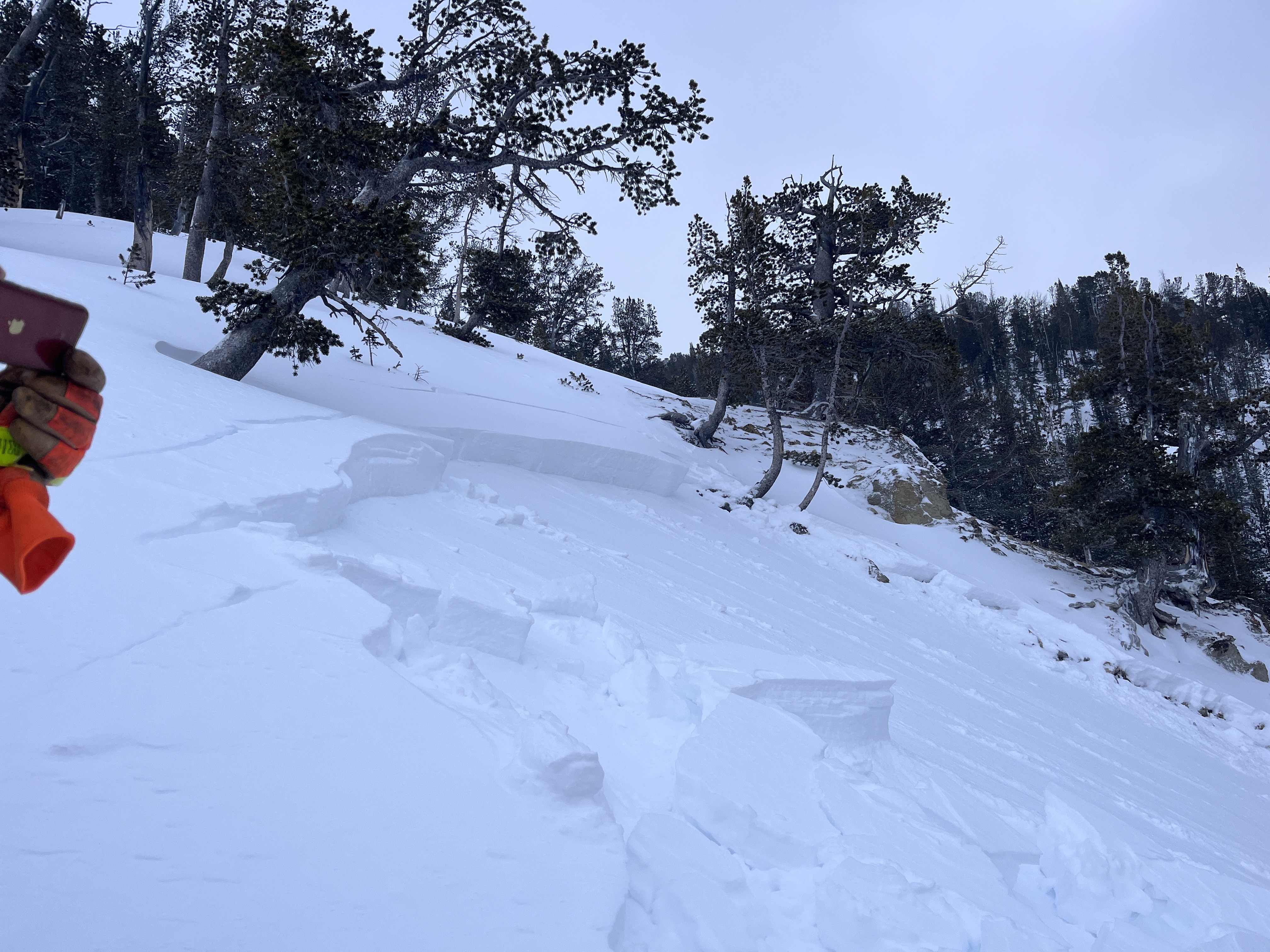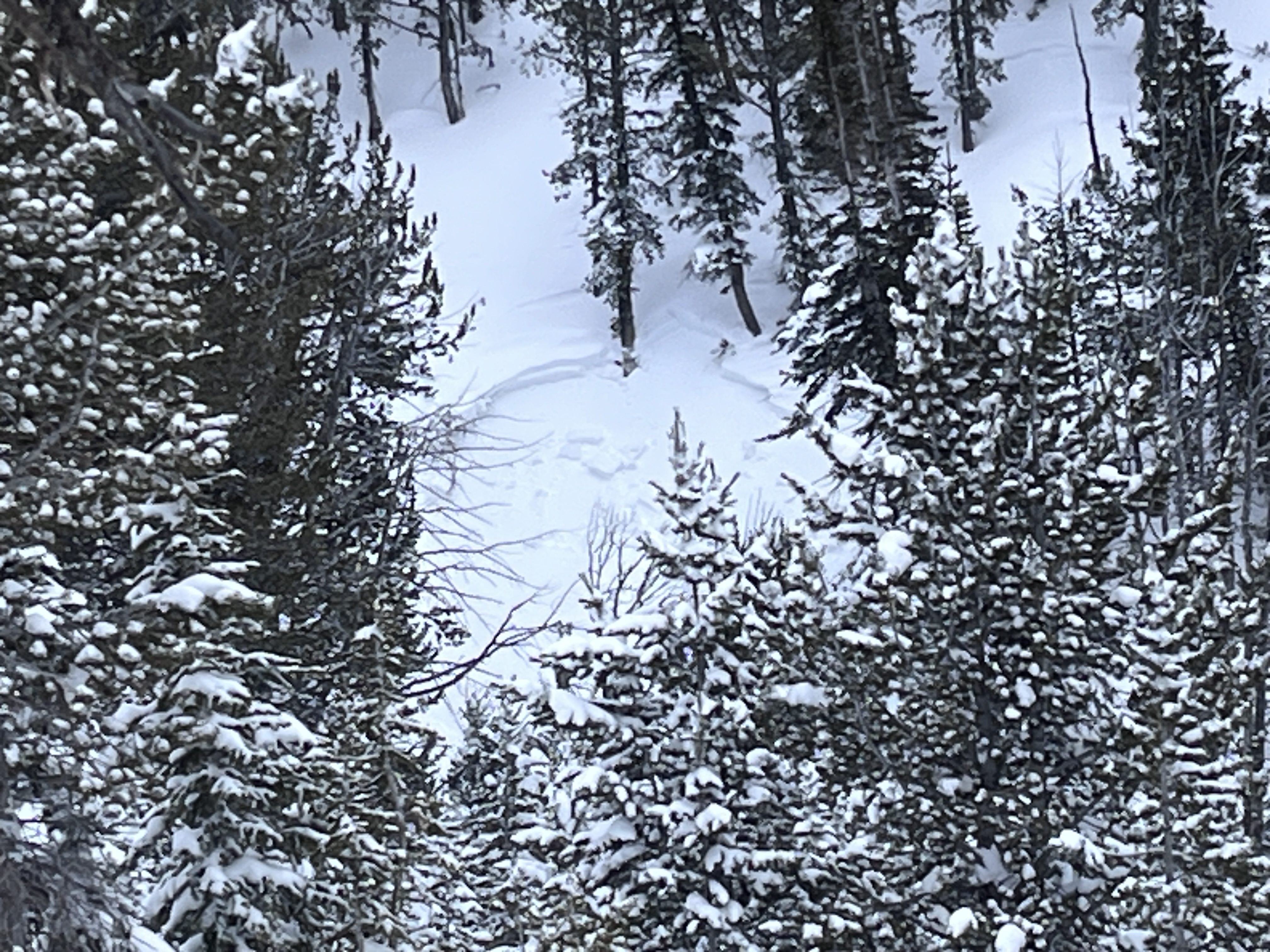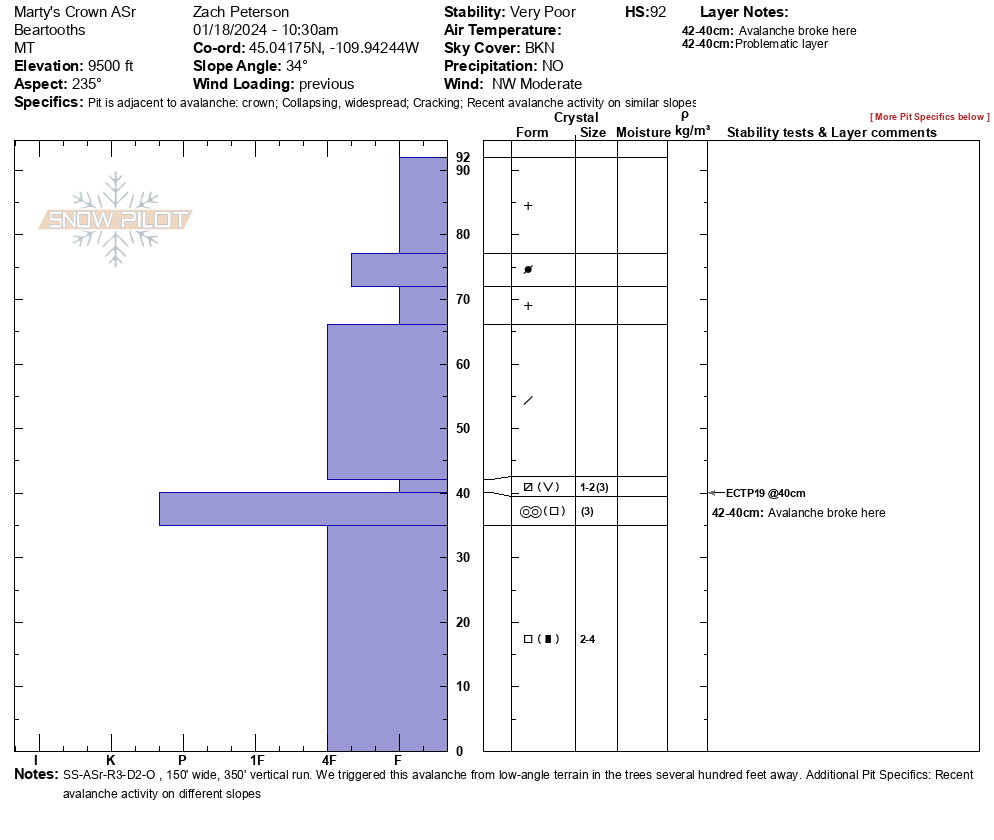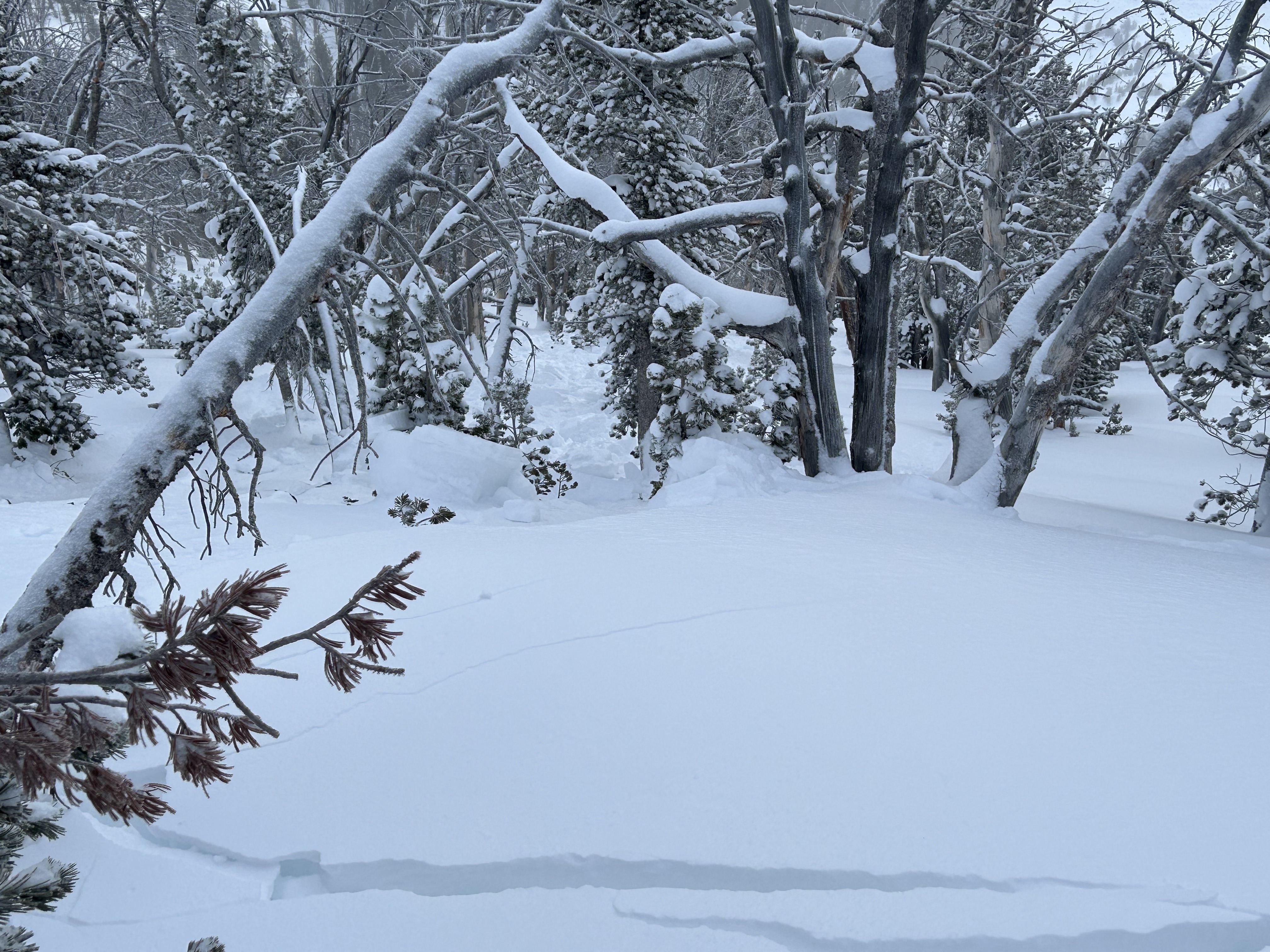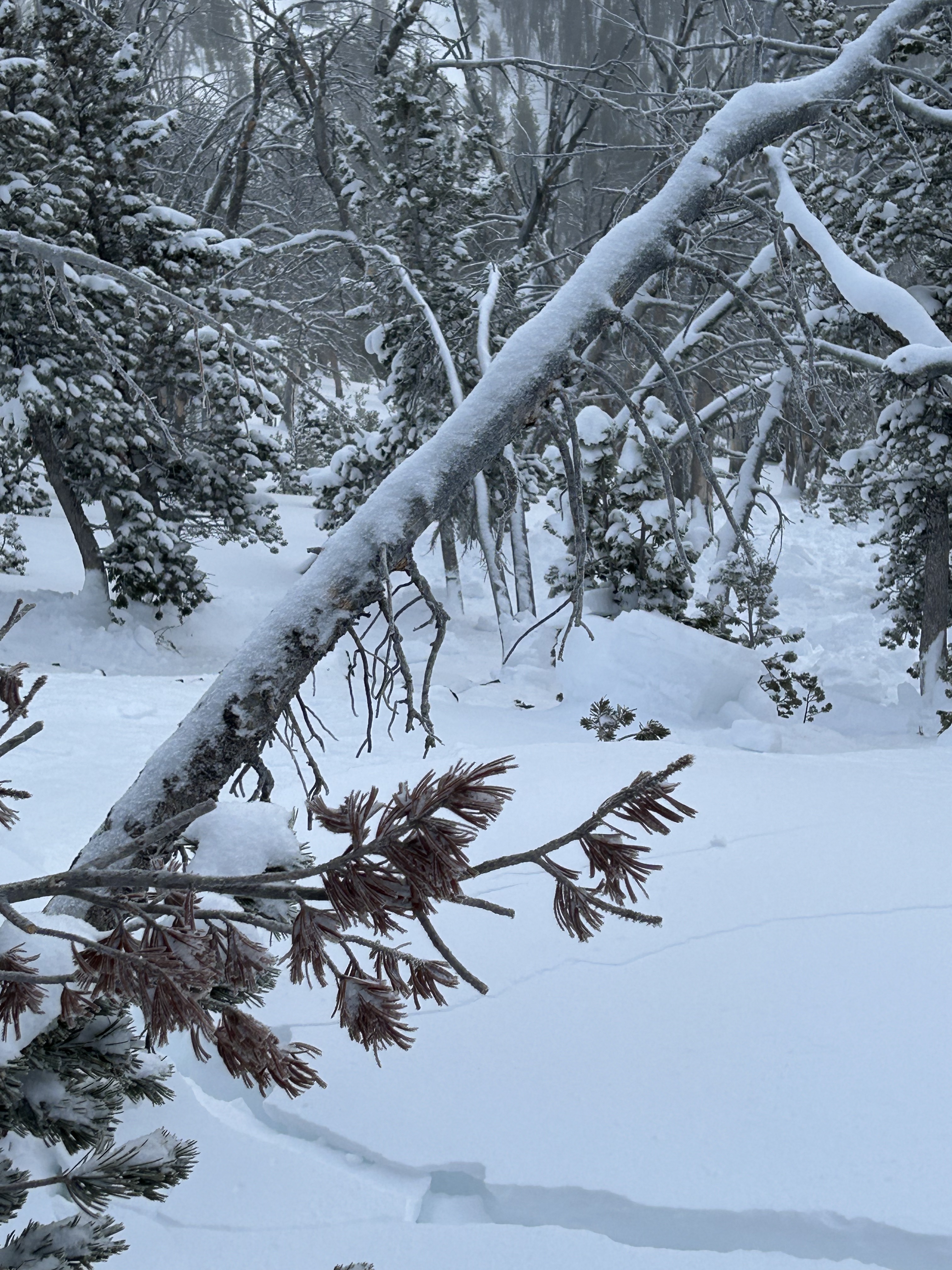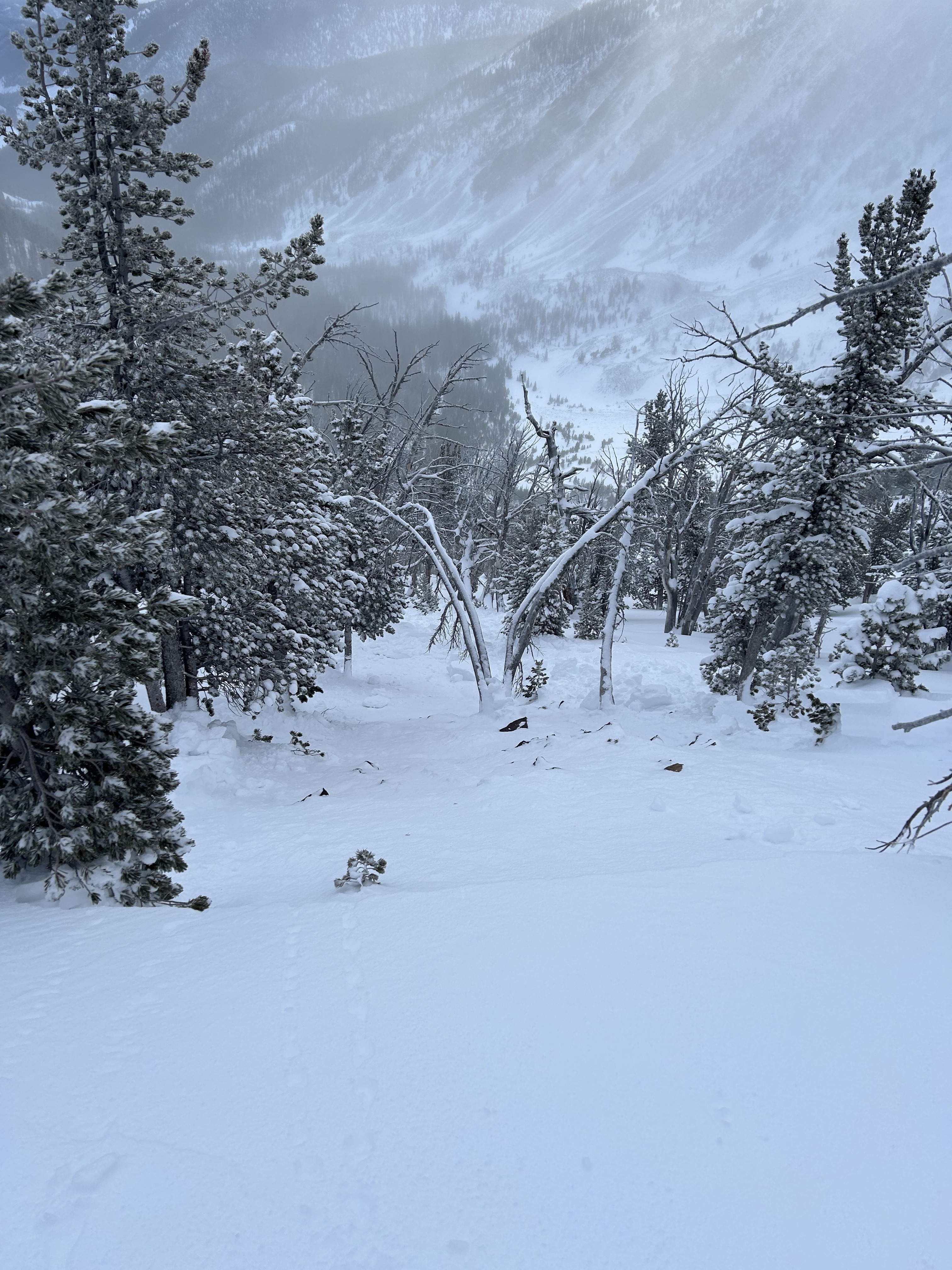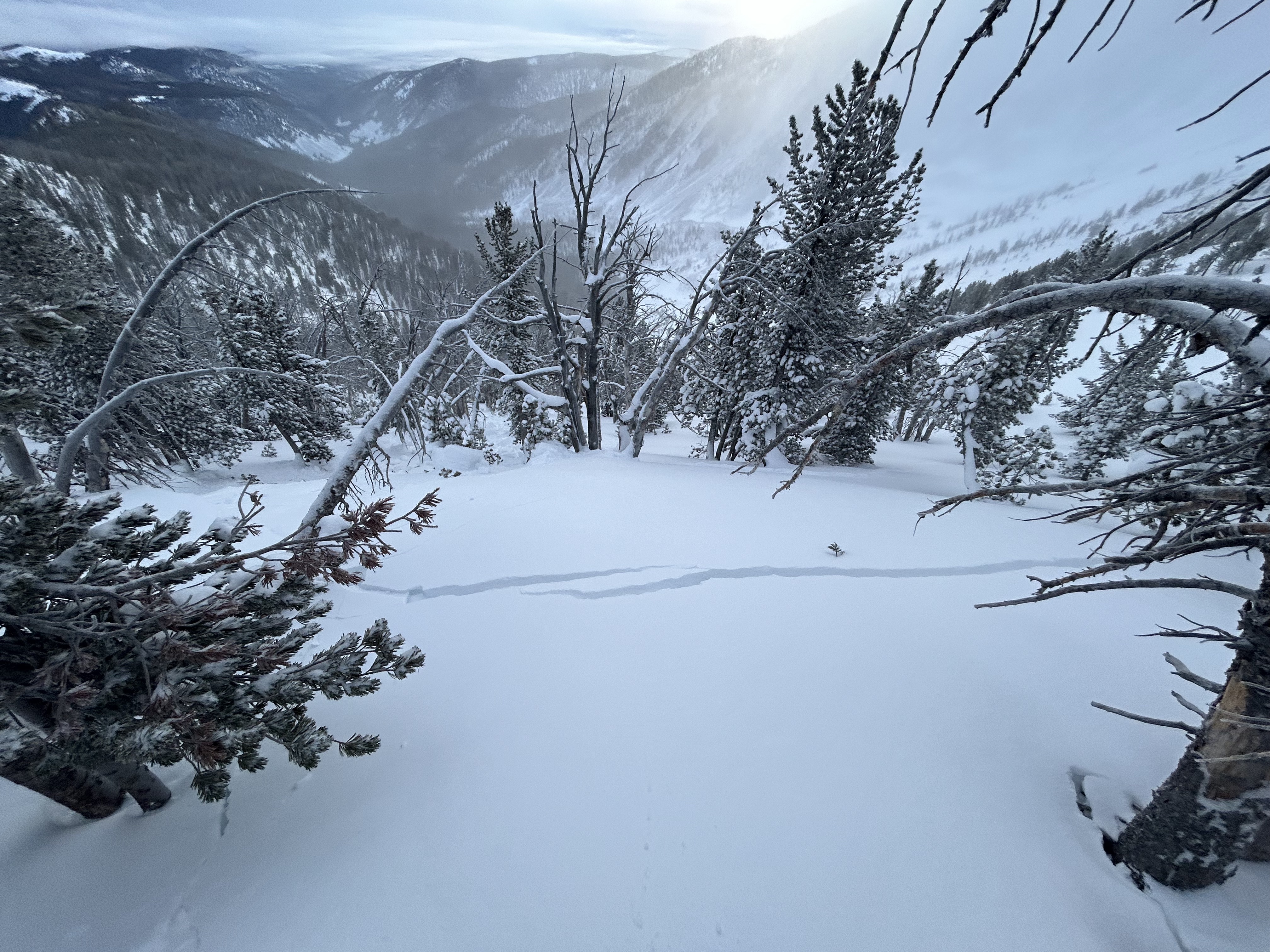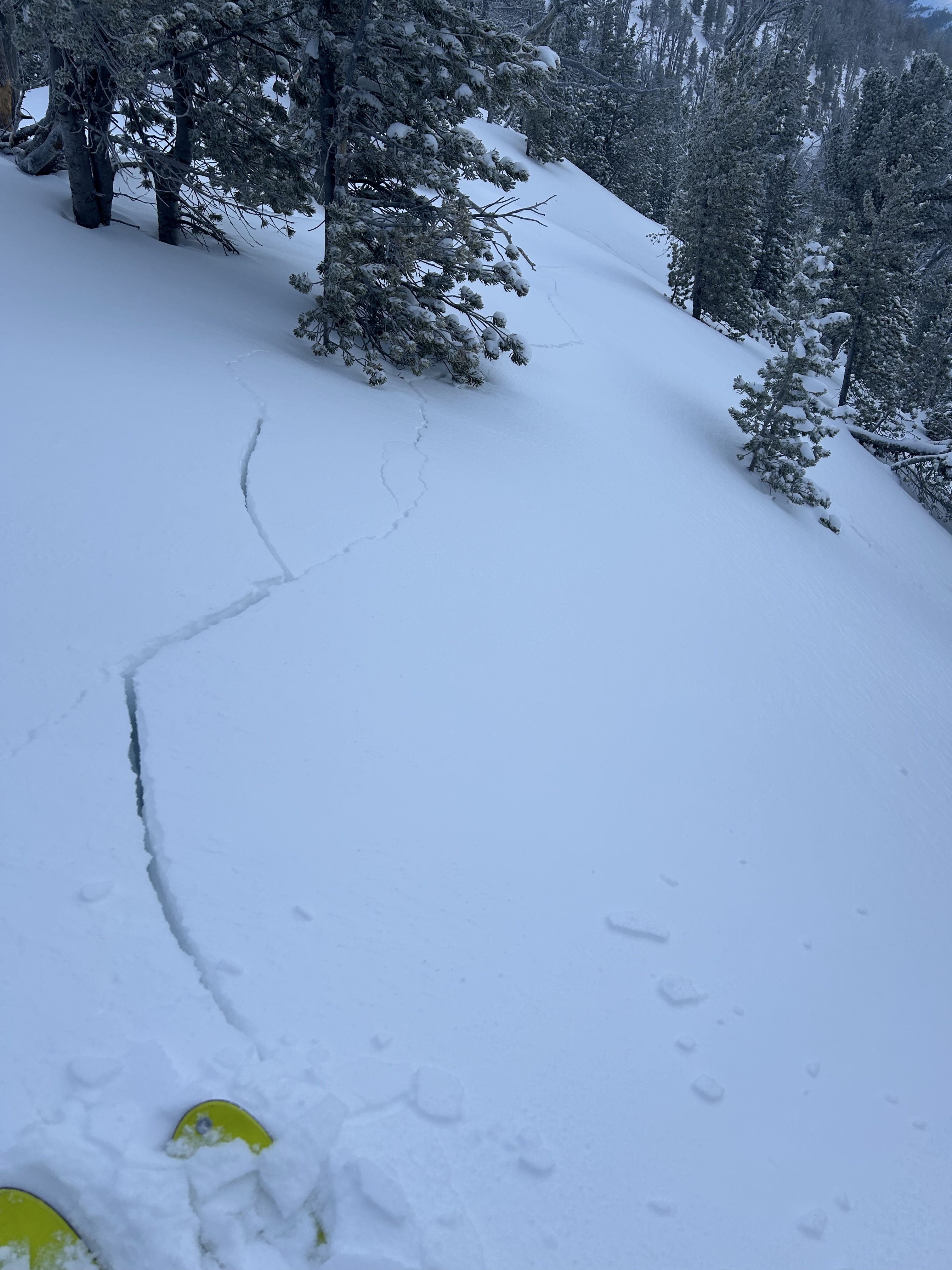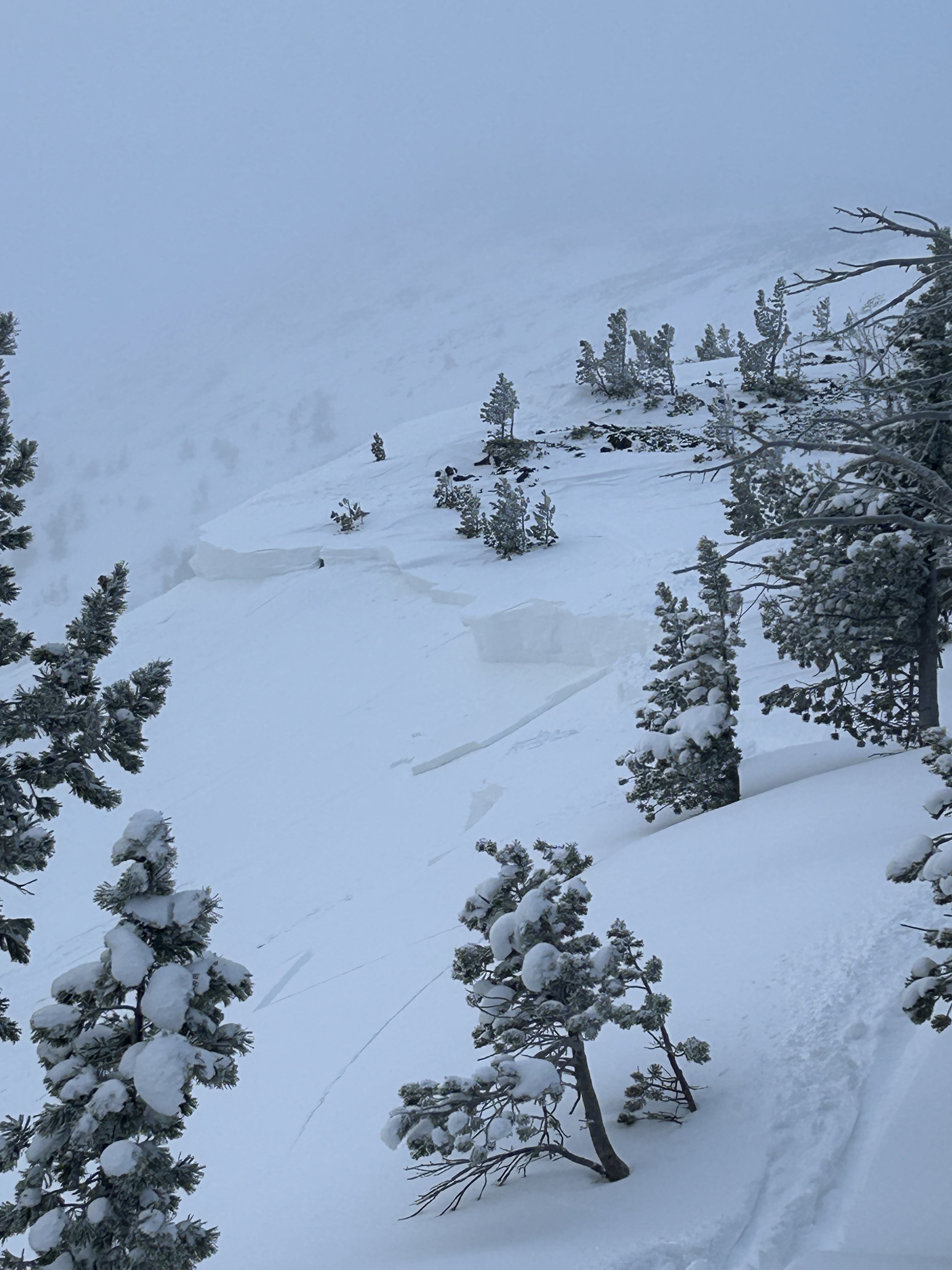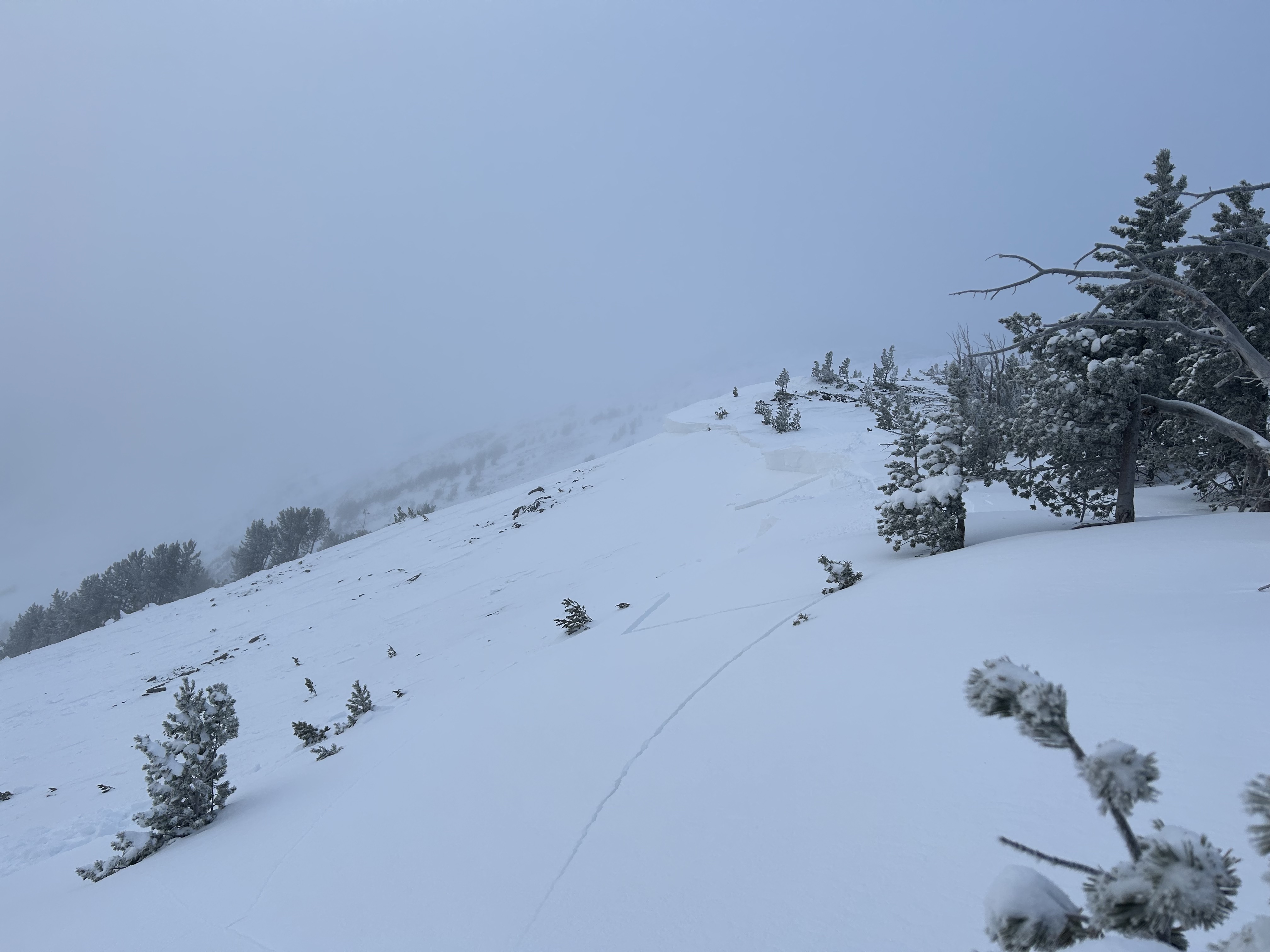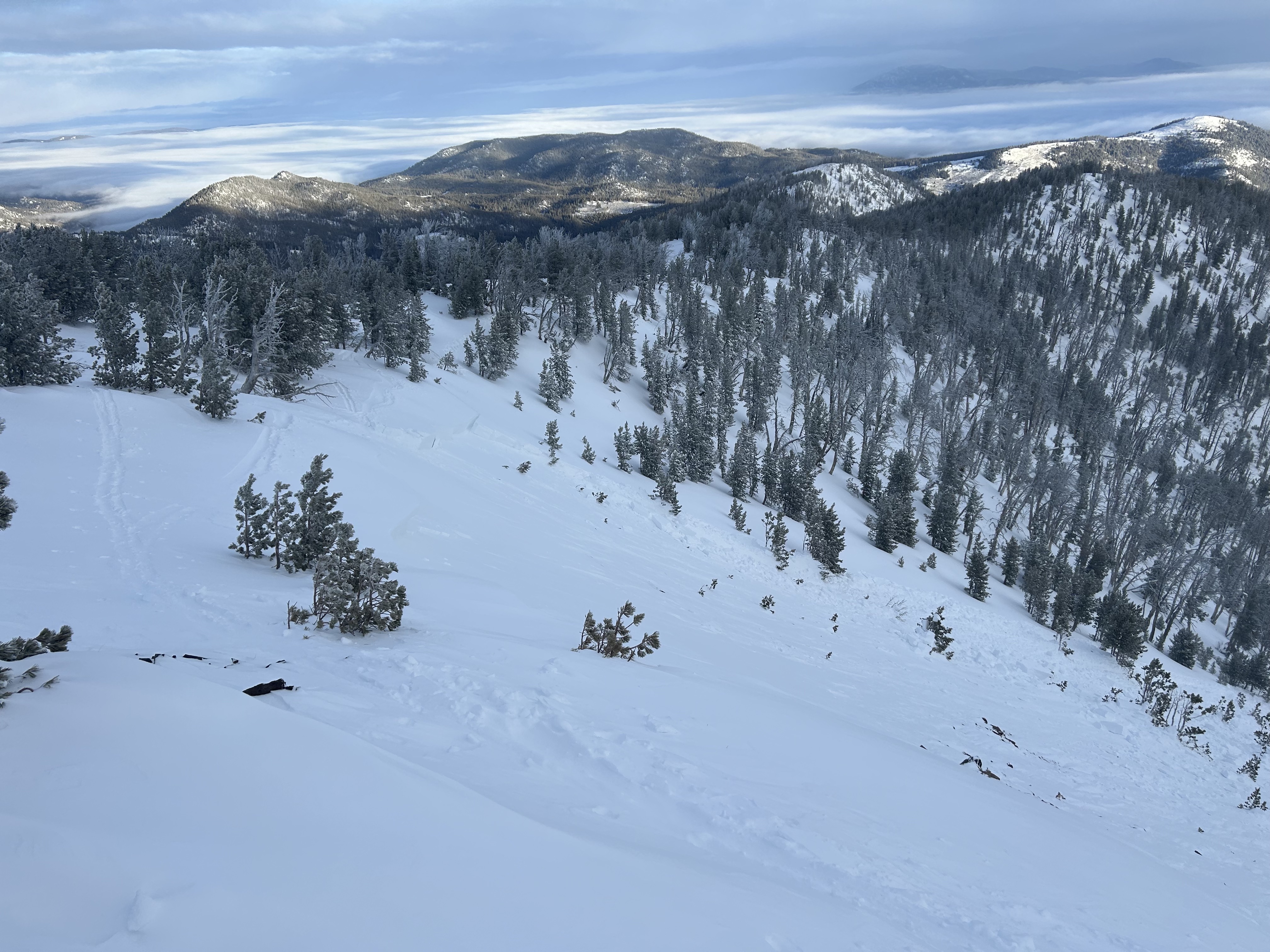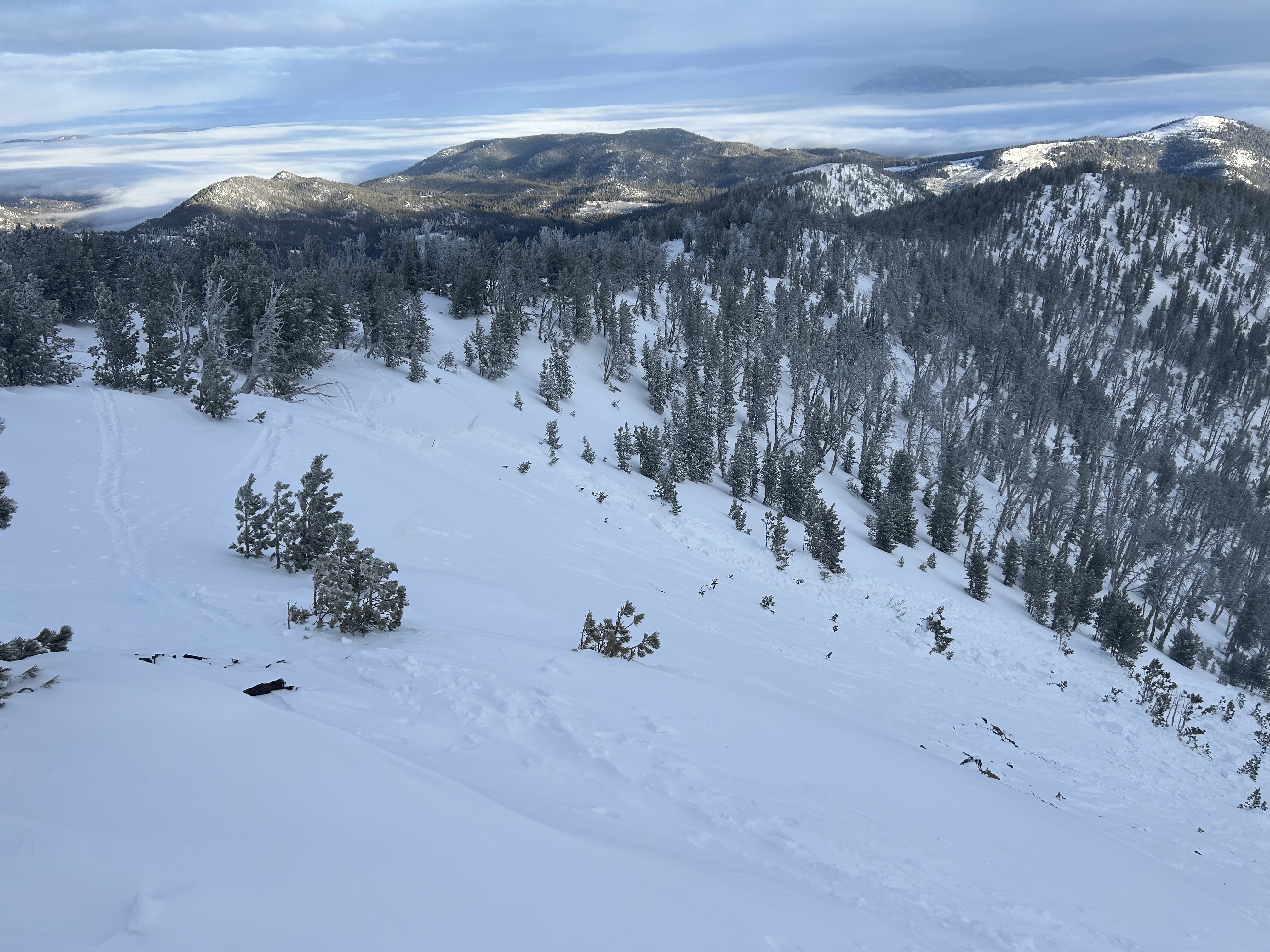Snow Observations List
Spent a day digging out the Hut in the Centennial Saturday 1/20. Our hasty pit, 20 deg. SW aspect at 7,000’ about 1/2 way into the hut showed 75 cm snow depth and various sized facets to a depth of 45 cm from the ground overlain by new snow. The structure was poor, and weak but we did not observe propagation in an ECT. Snow surfaces were damp on all aspect that we touched below 8,000’, pin wheel rollers on many steep slopes could be seen near the creek. Plenty of collapsing and “whumfing” on the way in kept us wary. Snow depths below 7,000 feet were as shallow as I have seen in 10 years operating the hut.
Full Snow Observation ReportToday's walk was difficult. Stepping off my skies I sank to the ground when over in middle basin. There was widespread cracking, collapsing, and whoompfing. A few smaller natural avalanches but not as many as I had expected with the feedback we were getting. Still great to get out.
Full Snow Observation ReportFrom email on 01/22: "
"On 1/19, my partners and I toured into Pebble Creek just west of Cooke in hopes to find some low-angle powder skiing. Our objective was to ski a south-facing slope just north of the Pebble Creek trail.
New snow totals were around a foot at 8000ft. Winds were pretty moderate out of the west/northwest, but it looks as if the days prior had transported a lot of snow off of the south-facing ridgelines onto east-facing slopes. We had many thunderous collapses on our way uphill that echoed across the entire canyon. It was pretty hair-raising even though we weren't above or below any avalanche terrain. Towards the top of our objective, we saw a natural avalanche that occurred on a small rollover that appeared to be a day or two old (pictured below). I suspect the slope was no steeper than 30 degrees. I did a quick hand shear on the adjacent slope and the overlying slab of new snow failed upon isolation. "
Full Snow Observation ReportFrom interaction at the gas station:
“We were riding out from Island Park. We saw dramatic, collapses, and shooting cracks. I side-hilled a small slope and triggered it 1.5 to 2 feet deep. I have never seen such unstable snow.”
Full Snow Observation ReportWe dug pits and rode on Sawtelle Peak. At 9,100 feet we had unstable test results (ECTP13 x 5; ECTP10 x2; CT4, Q1). When the clouds lifted we could see a crown of a snowmobiler triggered slide that occured yesterday. It broke on the buried surface hoar and facets about 1.5 feet under the surface. Recent snow and wind-loading has created dangerous avalanche conditions.
The avalanche:
Dug pits both above and below Bradley Meadows with a Fundamentals Course. We got ECTNx5 down 30cm on the facets which were first buried Jan 5th. The snow overlying the facets was soft (fist to four finger).
Full Snow Observation ReportObserved the avalanche breaking pretty far down the ridge, but I had a feeling it broke a little bigger judging by how fast the powder cloud was the moving. Went back up there today and saw that it had in fact, broke quite a bit bigger than the 8 inches and 50 feet I initially reported. Photo attached.
Full Snow Observation ReportA skier triggered an avalanche on the SE face of Mt. Blackmore near the ridge on the morning of 1/19/24.
From text: "Hard to with the visibility but it ran almost all the way to the skin track (~800 vertical). It definitely broke 8 inches deep and 50 ft wide, but it might've gotten a little wider and deeper."
Full Snow Observation ReportMultiple remotely triggered avalanches. Lots of shooting cracks and visible whomping(poofs of snow dust).
Triggered from over 140 yards
Full Snow Observation ReportPhotos from email. Avalanches previously reported - https://www.mtavalanche.com/node/30013
Full Snow Observation ReportFrom IG: “…, probably propagated a mile long, on a layer of advanced facets 30cm below a wind slab… We dug a pit yesterday and got a ct4, ectp9, pst 25/100 on the same layer.”
Full Snow Observation ReportFrom facebook message: "Multiple remote triggers across this slope."
Up Targhee Creek, near Lionhead Ridge. 1/18/24
Full Snow Observation ReportNatural & remote trigger avalanches observed on most steep terrain.
Full Snow Observation ReportAlex and I began to dip our toes into a Saddle Peak stability assessment. Given the new snow and HIGH danger on wind-loaded terrain in the Bridger Range, we decided early to skip the summit and cross onto the edge of the Football Field from the Bridger Bowl boundary. Upper slopes had fresh drifts of wind-loaded snow and new cornice growth, but there was not as much loading as we feared there might be. We stuck to our conservative plan and skied the "Bitter End" (the closest run to the south boundary of the ski area) down to 8400' elevation before ducking out across the boundary.
The snowpack is thin and weak, with advanced facets making up most of it. Our test results did not reveal obvious instability, just weakness (ECTX). It is unreasonable to apply that same assessment across the Peak. Human-triggered avalanches are certainly possible, especially in areas with thicker slabs of wind-drifted snow (something that is quite common to find on Saddle Peak). Given the very high-consequence nature of the area, we advise patience and conservative terrain choices and decision-making.
Full Snow Observation ReportThe danger felt like a CONSIDERABLE / MODERATE split. We did not observe any thick or reactive wind slabs on the boundary, possibly due to avalanche mitigation efforts at the Bitter End. Alex and I discussed the summit and a Skyline assessment but decided to hold off since we have high pressure returning and the optics of doing so with a HIGH danger on the map.
Without wind tomorrow, Alex and I discussed a return to the MODERATE danger. Remain nimble with regard to incoming observations, strong winds, or more snow and hold it up if additional information suggests it.
115-120 cm HS @ 8250'
Temp in the low 20's. Overcast until at least 3 p.m.
West side of tree trunks snowblasted by wind, both on the south and north sides of the ridge into Pebble Creek.
Experienced whoomphing starting at 8000', midway up the gully, south side of the ridge, where there was some wind deposition. Parallel cracks 10' apart - looked like "stretch" marks. Extensive whoomphing in the saddle and down in Pebble Creek Valley. Ski penetration = knee deep, and trail breaking was a bit of work today. 18" new snow at 8250' and in Pebble Creek. Snow was too deep for turns on mellow slopes, and too much collapsing to go steeper. Occasionally broke through the hard layer, into the hollow below.
Still windy in Pebble Creek (less than 10 mph), but definitely wind scoured. Looked like a natural avalanche on SE facing slope of the ridge to the N of Pebble Creek.
Coverage still slim down towards the highway.
Full Snow Observation ReportWe skinned up towards Hyalite peak today to see how the snowpack was adjusting to this new load. While we did see some point release on the canyon walls during our approach, there was no collapsing and minimal wind effect below 9000 feet. As soon as we topped out into the hyalite lake basin, a northerly wind picked up and there were supportable wind drifts scatted about. Got an ECTx on a northern aspect at 9200' before deciding to ascend a 25 degree adjacent slope. About 50' from our pit we remotely triggered two D1 slab avalanches which broke on the roll over 150' above us. Crowns looked between 1-2' and 20-30' wide. The larger of the two ran 100' more or less. Yikes, time to bail! The low angle tree skiing along the skinner was quite nice.
Full Snow Observation ReportNorth of Cooke City we observed numerous avalanches that likely happened last night or early this morning as snowfall stopped. Partly cloudy skies gave us a good view of the terrain and ridgelines. In the Fisher Creek drainage, we saw multiple natural avalanches on the east side of Henderson Moutain, including just south of Henderson Mountain off the Lulu Pass Road. At the back of the drainage, we saw another avalanche on the shoulder of Scotch Bonnet Moutain. Crown depths ranged in size but from afar seemed to be 1-2' deep. Several of these avalanches are wide and in sheltered terrain at mid-slope.
On the other side of Henderson Moutain in the Miller Creek drainage, we observed avalanches in the gully near the Daisy Pass road. Along the east side of the Miller Ridge, we saw large natural avalanches that happened just below the ridge line. On the south side of Crown Butte, the story didn't change with two large avalanches happening mid-slope, and near the summit. Again these crowns ranged in depth from 1-2' deep and deeper on the south side of Crown Butte.
On the west side of Henderson Moutain, we transitioned to skis and began ascending a low-angle slope toward a known avalanche path. Along the way, we experienced several collapses. Halfway up the slope, Ian noted snowballs rolling down the hill and around the corner, we could see the debris that had come from the steep terrain above. We had a clear view of this slope near the snowmobiles and it had not avalanched when we began ascending. At some point from several hundred feet away, we remotely triggered the slope. The avalanche was ~150' wide, 2' deep and ran almost to the road. Across the gully, we could see large cracks but the slope did not avalanche. Above, cracking and collapsing continued and we got a view into the upper part of the gully and saw another crown of an avalanche that likely happened at the same time as the slope below.
Roads that were groomed last night and by 9 am had wind drifts that were a few feet in size. The snow has stopped but the wind remained blustery through the morning and into the afternoon. Getting on or under steep terrain today was certainly not in our travel plans, and it will remain that way at least through the weekend.
More photos and video coming soon!
Full Snow Observation Report
4-6" of new snow. active transport with increasing sw winds. NE facing ridge. 9200'.
Full Snow Observation ReportWent for a short tour near bacon rind, next pulloff to the south, toured up the burned out hill right across the street. It was real windy leaving my vehicle. Some notable whoomphing, and cracks forming 30 ft around me. I probably won’t be riding down there for a bit, the low angle stuff I like is too thin. Real thin down there with only about 40-60cm on the ground. Got a CT1 SC Q2 breaking about middle of snowpack, ectn 2, and ectp24.
Full Snow Observation ReportModerate to Strong, SW winds were picking up this evening at Lick Creek, resulting in moderate snow transport along the ground. Previous drifts were building in leeward aspects and small terrain features, and I noted several areas of very dense wind board while skiing and touring. I also observed some local collapsing of these wind slabs around my skis, and would expect this issue to be exacerbated higher elevations by increased wind transport and the widespread presence of pwls. I was surprised by the amount of snow available for transport, especially at the relatively low elevation, and was glad to be in simple, low-angle, terrain.
Full Snow Observation Report

